Creating a welcoming family room that balances style with functionality requires thoughtful planning and current design knowledge. Family rooms in 2025 are becoming more personal, functional, and formal, moving away from cookie-cutter spaces to environments that blend comfort with artistry. This year's trends emphasize comfort as king, with plush sofas, oversized cushions, and cozy blankets marking inviting spaces where families can relax and unwind. These twenty family room ideas incorporate the latest design movements while ensuring your space serves your family's daily needs.
1. Family Room Comfort-Driven Sectional Design
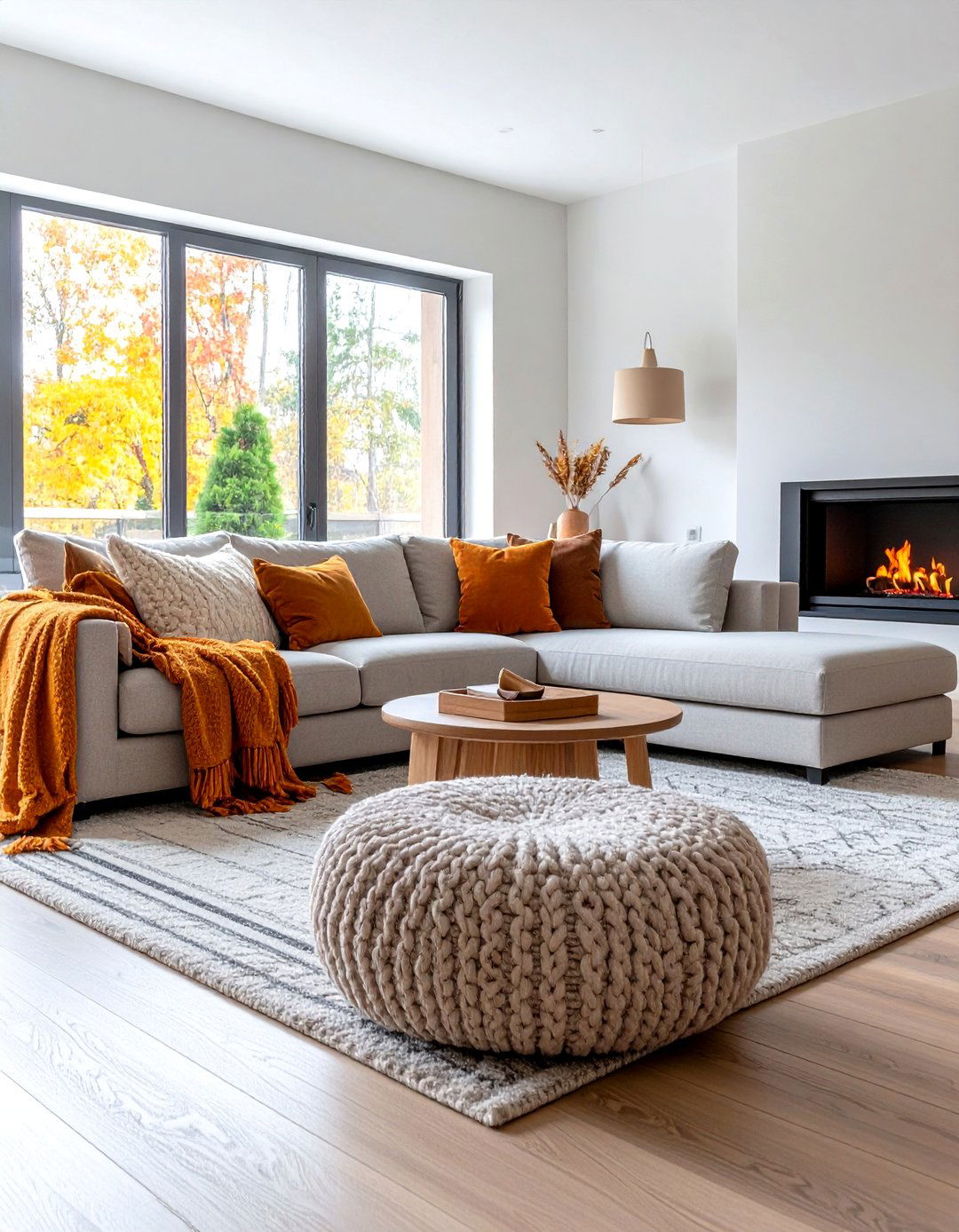
Comfort-driven design prioritizes plush sofas, oversized cushions, and cozy blankets as a response to the growing need for homes that provide shelter from daily stresses. Create the ultimate family gathering space with a deep-seated sectional featuring performance fabrics in neutral tones. Layer multiple throw pillows in varying textures like boucle, velvet, and linen for tactile appeal. Position the sectional to face both the fireplace and television, ensuring optimal comfort for family movie nights. Add a large ottoman that doubles as extra seating and storage for blankets. Complete the look with soft lighting from table lamps and strategically placed floor lamps to create a warm, inviting atmosphere that encourages relaxation and connection.
2. Family Room Jewel Tone Color Scheme

Jewel tones like rich emeralds or deep amethysts are being used sparingly to punctuate neutral spaces, bringing depth without overpowering. Transform your family room with sophisticated jewel tones that add richness and personality. Start with a neutral foundation of cream or soft gray walls, then introduce deep emerald green through an accent chair or rich sapphire blue via throw pillows. Layer in warm metallics like brass or copper through lighting fixtures and decorative objects. Use these bold colors strategically—perhaps 20% of your color palette—while maintaining neutral larger pieces. This approach creates visual interest without overwhelming the space, allowing you to easily refresh the room by swapping out smaller accent pieces seasonally.
3. Family Room Modern Coastal Farmhouse Style
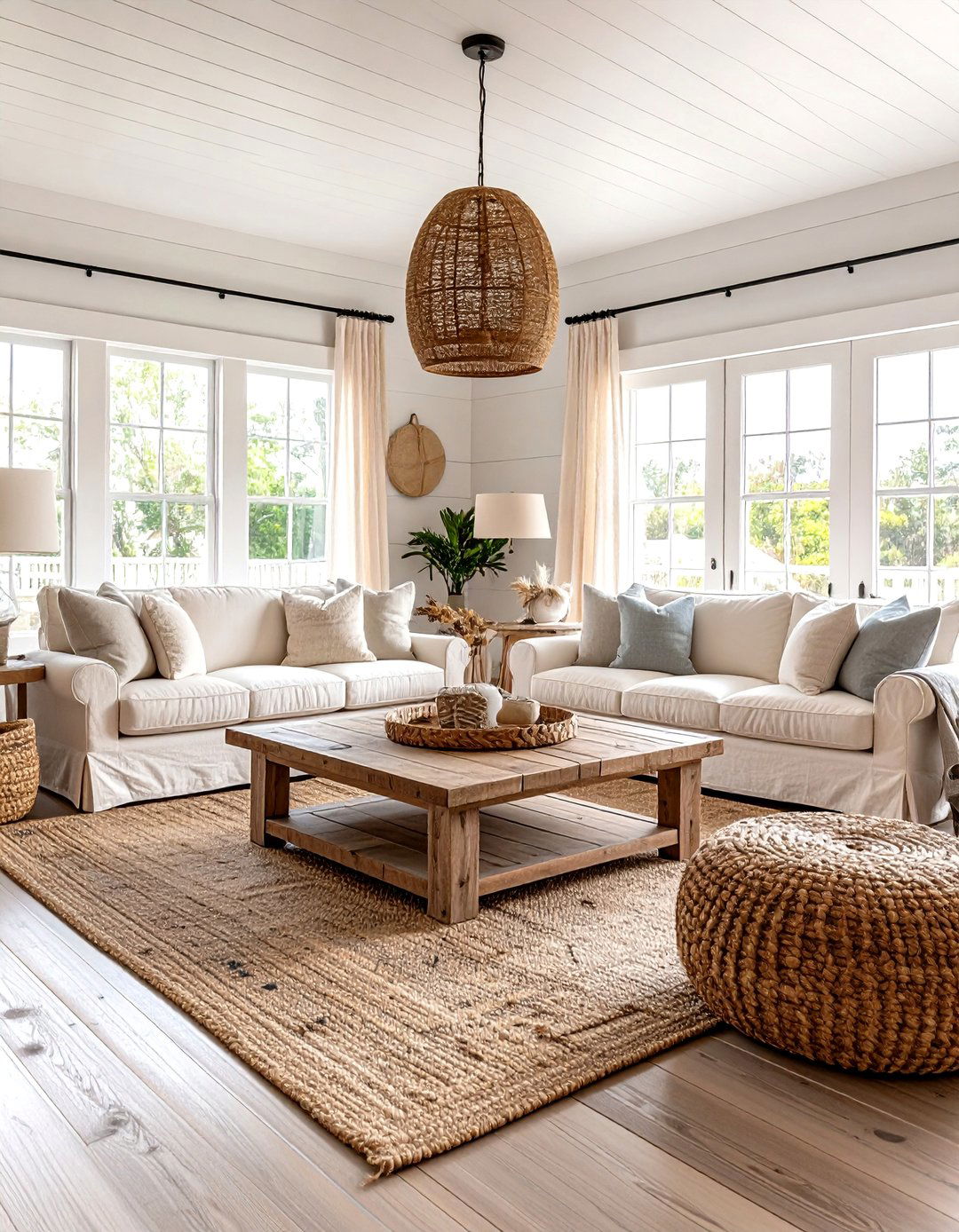
Modern coastal farmhouse incorporates beach-inspired decor and light wood finishes with rustic-meets-modern aesthetics using black accents and earthy tones. Blend the relaxed comfort of coastal style with farmhouse charm through clean white walls, shiplap accents, and natural wood furniture. Choose slipcovered sofas in white or cream linen, paired with weathered wood coffee tables and natural fiber rugs. Incorporate black metal accents through light fixtures and hardware for modern contrast. Add subtle coastal elements like rope details, woven baskets, and soft blue-green accessories without overwhelming the space with nautical themes. This style creates an airy, timeless atmosphere perfect for families seeking both sophistication and casual comfort.
4. Family Room Open Concept Layout
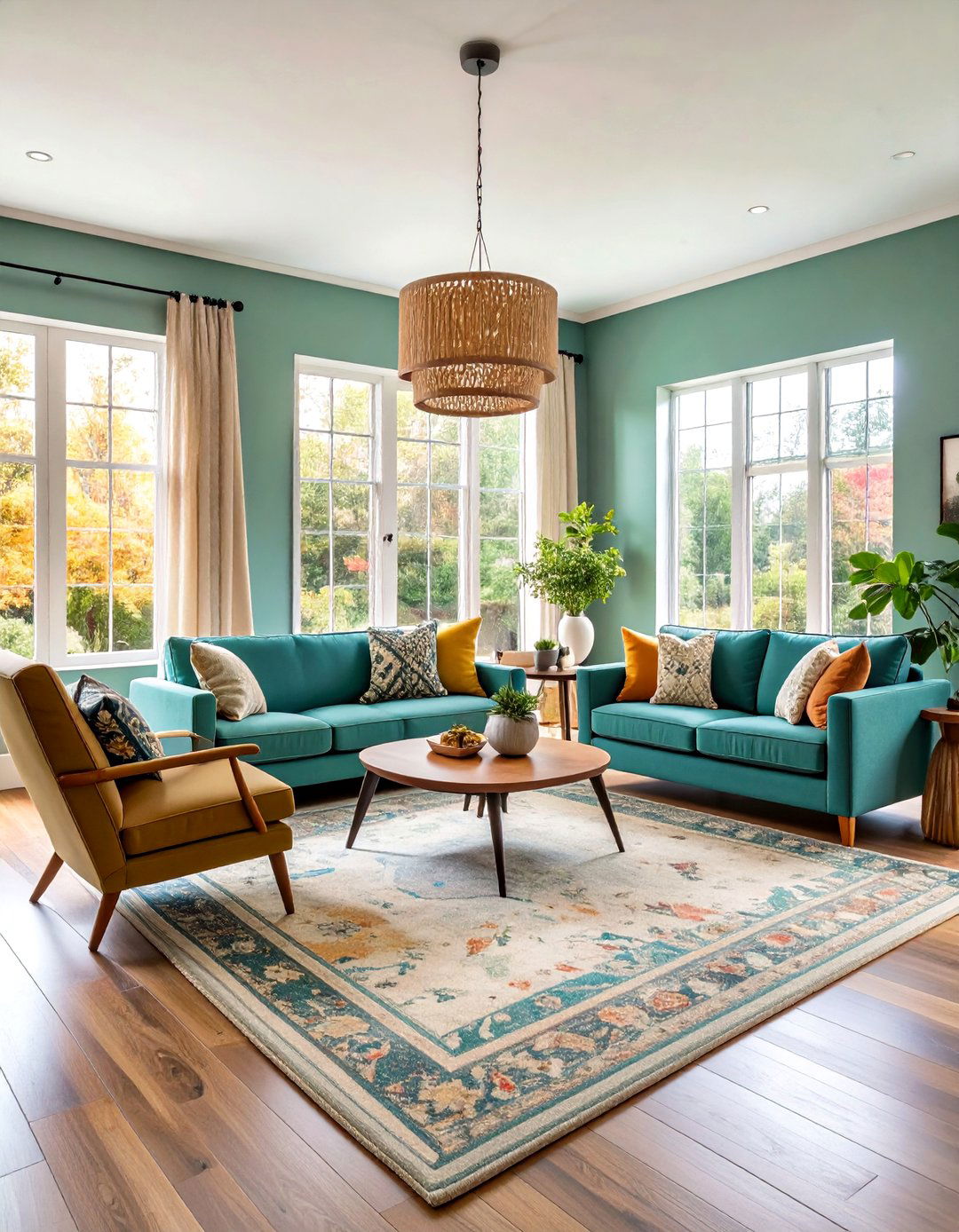
Making the most of alcoves and cozy corners can create versatile, multi-functional areas when bringing together different elements like seating, play, and entertainment zones. Design distinct zones within your open family room by using furniture placement and area rugs to define spaces. Create a main conversation area with seating arranged around a central coffee table, then establish a secondary reading nook with a comfortable chair and side table near windows. Use a console table behind the sofa to separate the family room from dining areas while providing display space. Position children's play areas in corners where supervision is easy but toys don't dominate the main seating area. This layout maximizes functionality while maintaining visual flow throughout the space.
5. Family Room Layered Lighting Setup
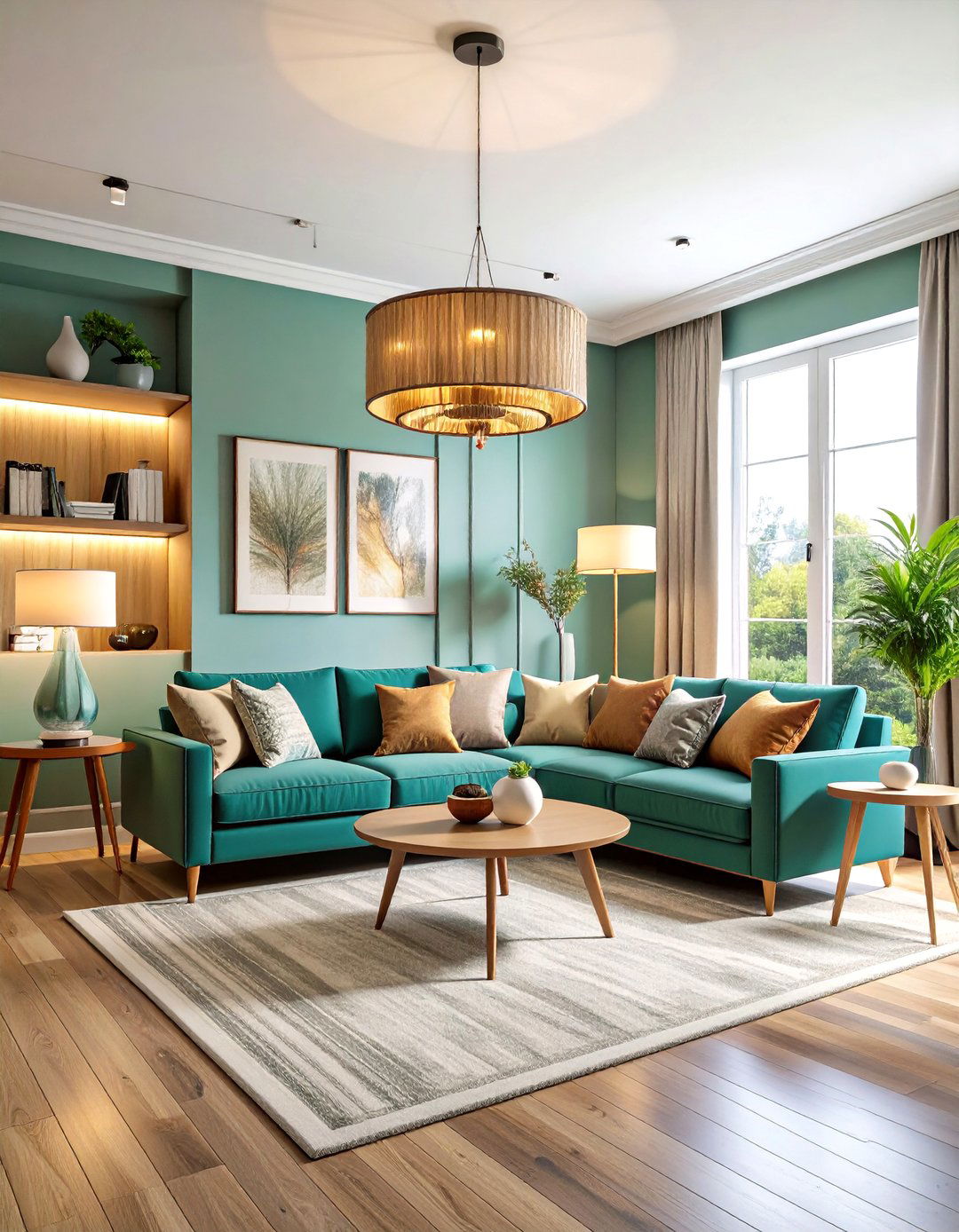
Statement fixtures and layered lighting are trending for 2025, with architectural lighting in sconces, chandeliers, and sculptural floor lamps replacing purely functional lighting. Create ambiance with multiple light sources at different heights to accommodate various family activities. Install a statement pendant or chandelier as your central fixture, then add table lamps on side tables for reading light. Include floor lamps in corners to eliminate dark spaces and consider sconces flanking artwork or built-ins. Add LED strip lighting behind floating shelves or entertainment centers for modern ambiance. Install dimmer switches on all fixtures to adjust lighting for different moods—bright for homework time, soft for evening relaxation. This layered approach ensures optimal lighting for every family member's needs.
6. Family Room Built-In Storage Solutions
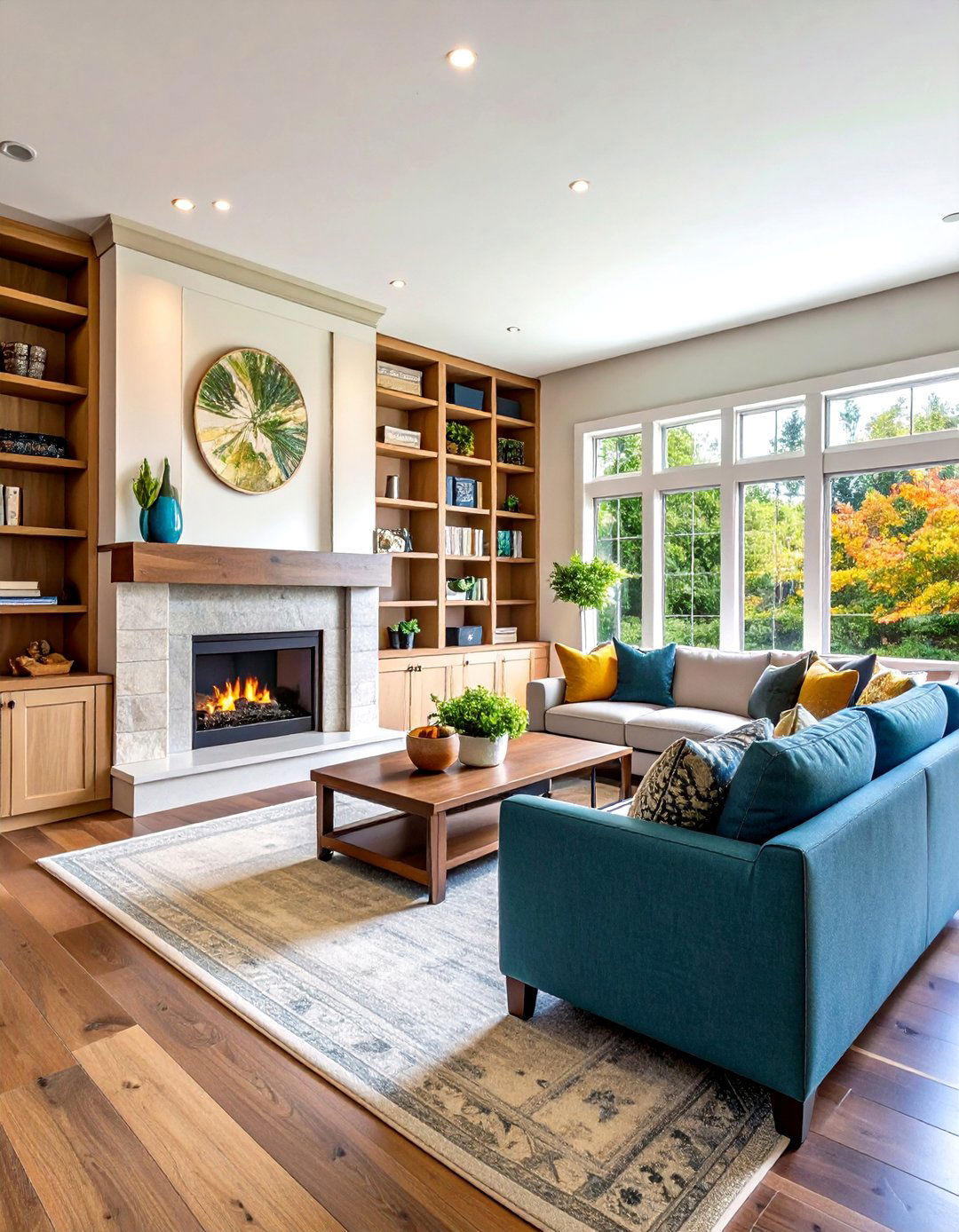
Family room designs should accommodate all items usually kept in such spaces, whether with built-ins or freestanding furniture, especially for families with kids where toys might be an issue. Maximize organization with custom built-ins that blend seamlessly with your room's architecture. Design floor-to-ceiling units flanking the fireplace with a combination of open shelving for books and decor, plus closed cabinets for hiding electronics, games, and children's toys. Include a media center with cord management systems to maintain clean lines. Add bench seating with lift-up storage in window areas or alcoves. Consider modular storage systems that can adapt as your family's needs change. These solutions maintain the room's aesthetic appeal while ensuring everything has a designated place, reducing daily clutter and stress.
7. Family Room Curved Furniture Arrangement
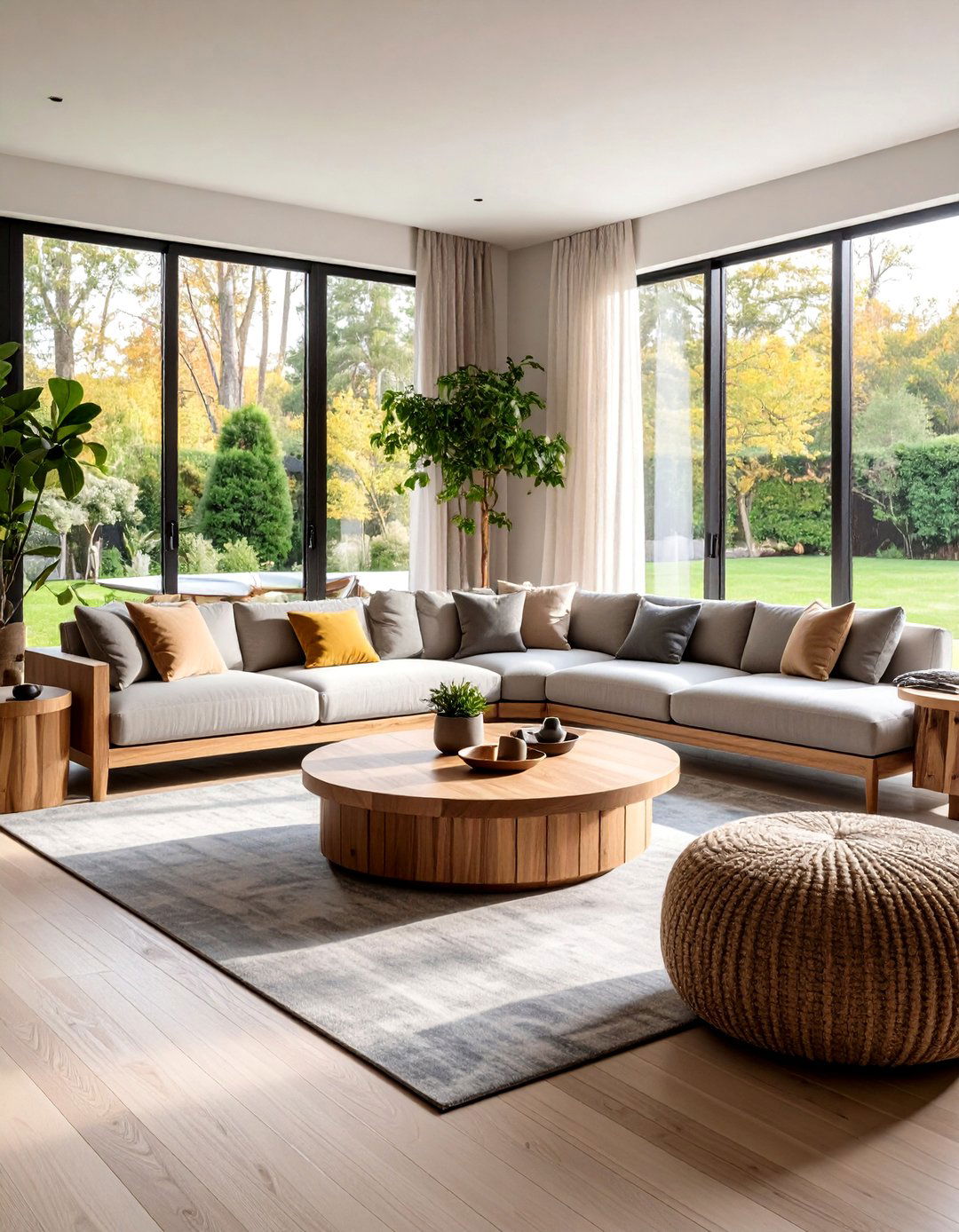
Curved sofas are becoming more common as part of the growing trend of organic shapes, live plants, and earthy colors—a reaction to clean lines and minimalist trends. Soften your family room's geometry with curved and organic-shaped furniture that encourages intimate conversation. Choose a curved sectional or arrange seating in a circular pattern around a round coffee table to facilitate better family interaction. Add organic-shaped side tables and rounded ottomans to complement the flowing lines. Include plants in curved planters to reinforce the natural, organic feel. This arrangement breaks away from rigid rectangular layouts, creating a more welcoming atmosphere that feels cozy and contemporary. The curved elements also help with traffic flow, eliminating sharp corners that can be problematic in active family spaces.
8. Family Room Textured Wall Feature
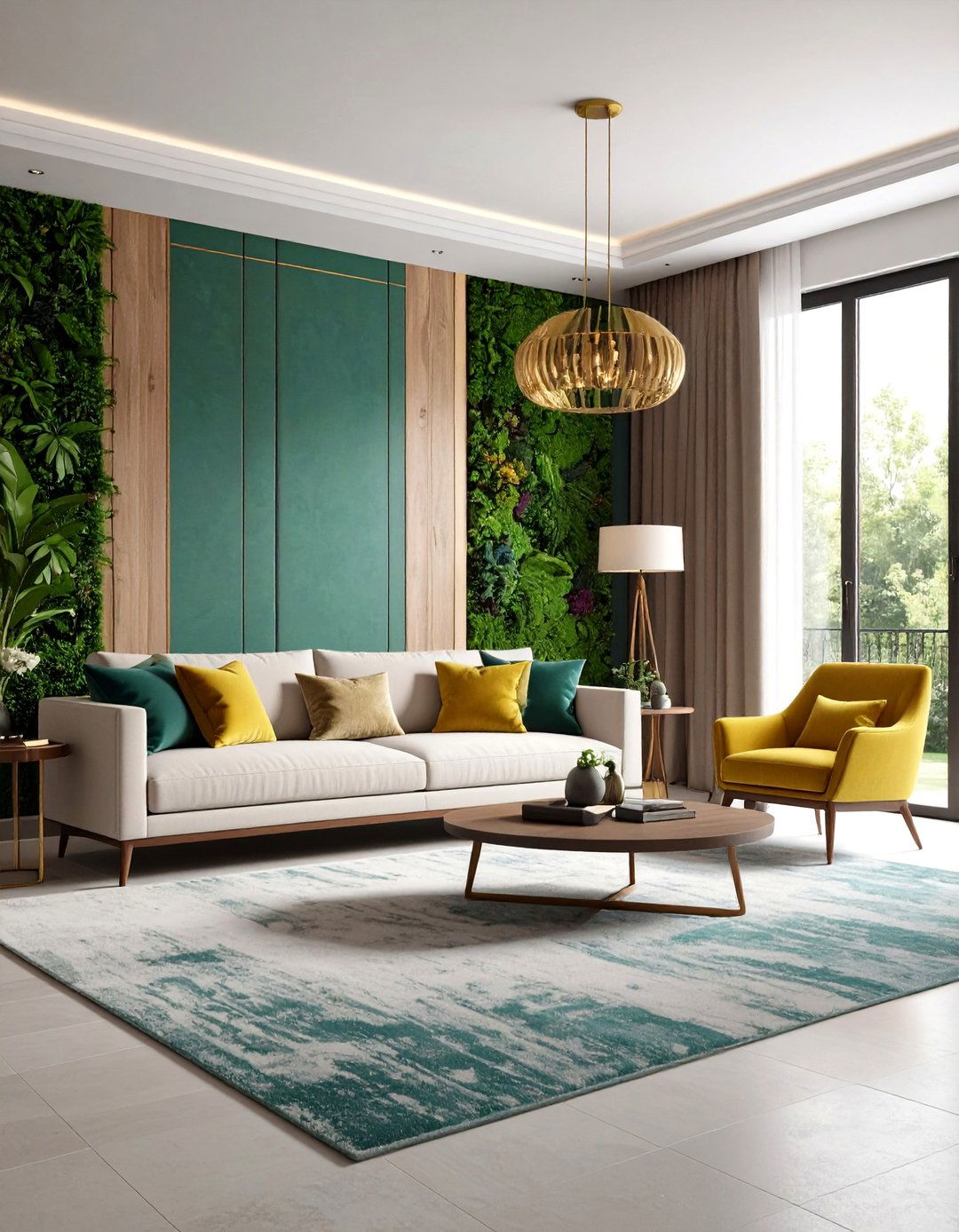
Textured walls from wallpaper with intricate patterns to wall panels with three-dimensional designs can instantly enrich layouts with depth and interest. Create visual drama with a textured accent wall that serves as your room's focal point. Consider grasscloth wallpaper for subtle elegance or three-dimensional wall panels for bold statement-making. Shiplap remains popular for its farmhouse appeal, while board-and-batten wainscoting adds traditional charm. Stone or brick veneer provides rustic texture, perfect behind entertainment centers or fireplaces. Choose textures that complement your overall design style—smooth and sleek for modern spaces, rough and organic for rustic themes. The textured wall should enhance rather than compete with your furniture, creating depth without overwhelming the space.
9. Family Room Vintage-Modern Mix
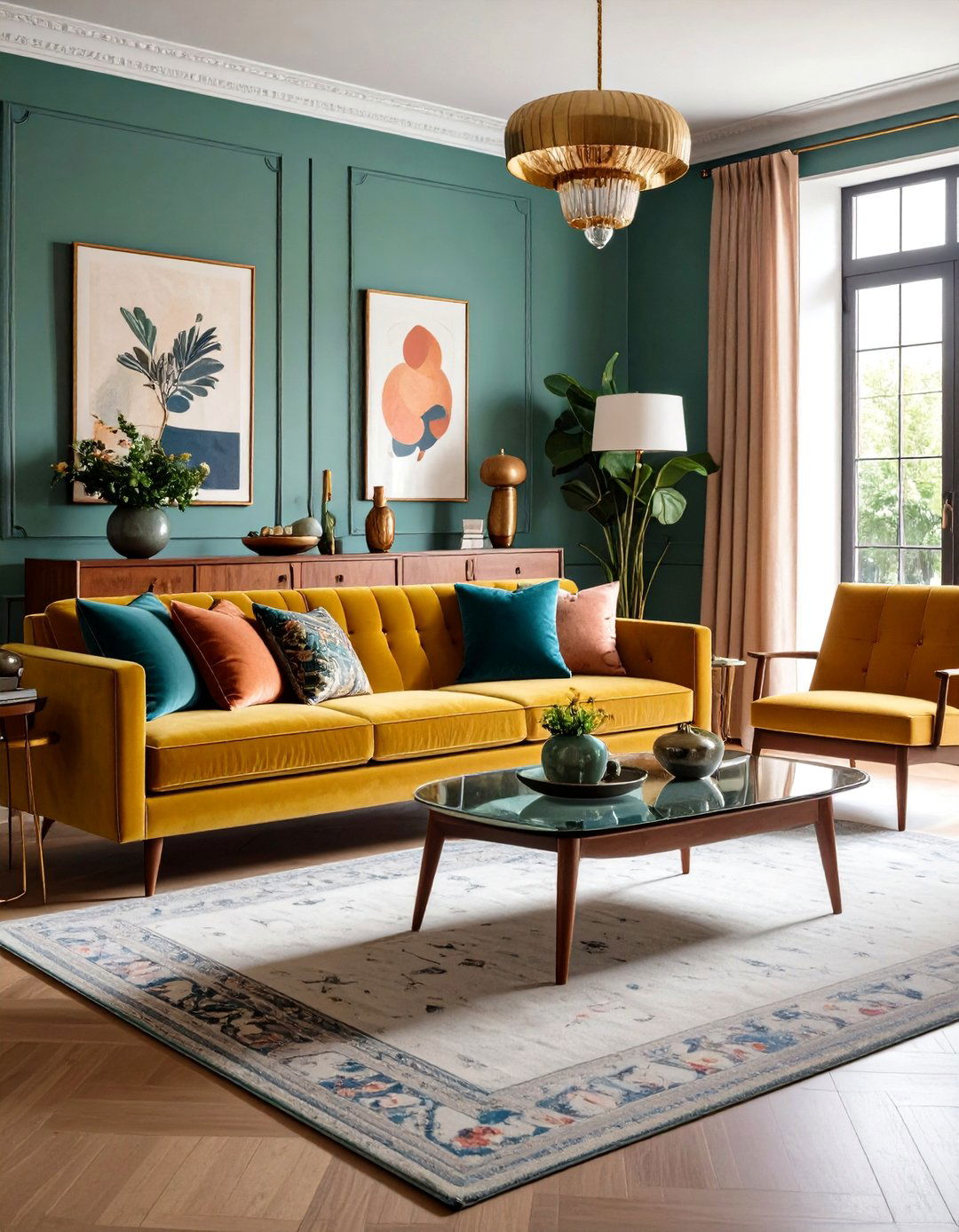
Vintage-inspired family room trends reflect an eclectic fusion of styles where iconic pieces like low-profile sofas, velvet armchairs, and classic wood sideboards make a comeback paired with contemporary accents. Balance nostalgia with contemporary flair by mixing vintage finds with modern pieces. Start with a classic mid-century modern sofa in rich velvet, then pair it with a sleek glass coffee table and minimalist lighting. Include vintage accessories like a retro bar cart or antique wooden sideboard alongside contemporary artwork. This layered approach creates a space filled with character and stories while maintaining current functionality. The key is maintaining proportion—let vintage pieces shine without overwhelming the space, using modern elements to keep the overall feel fresh and current.
10. Family Room Entertainment Zone Design
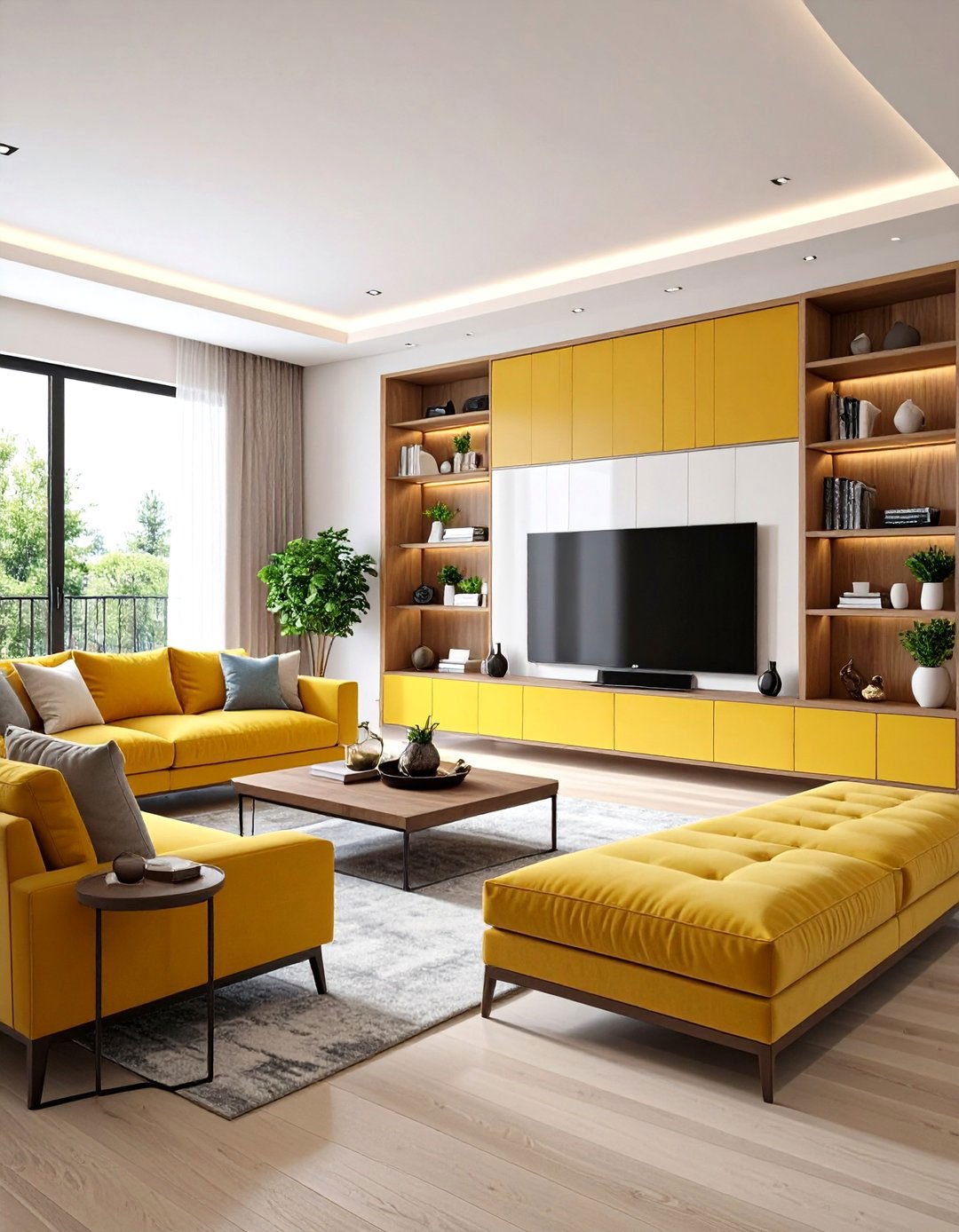
People are leaning towards conversational spaces versus setting up rooms purely for media and entertainment, while still accommodating technology needs. Create a sophisticated entertainment area that doesn't dominate your family room's aesthetic. Mount the television at eye level and surround it with built-in shelving to minimize its visual impact when not in use. Choose a media console with closed storage to hide electronics and cable management systems. Arrange seating to accommodate both conversation and TV viewing—perhaps a main sofa facing the screen with additional chairs angled for easy conversation. Include gaming storage in attractive baskets or cabinets. Consider a projector and retractable screen for special movie nights while maintaining the room's primary function as a gathering space.
11. Family Room Sustainable Materials Focus
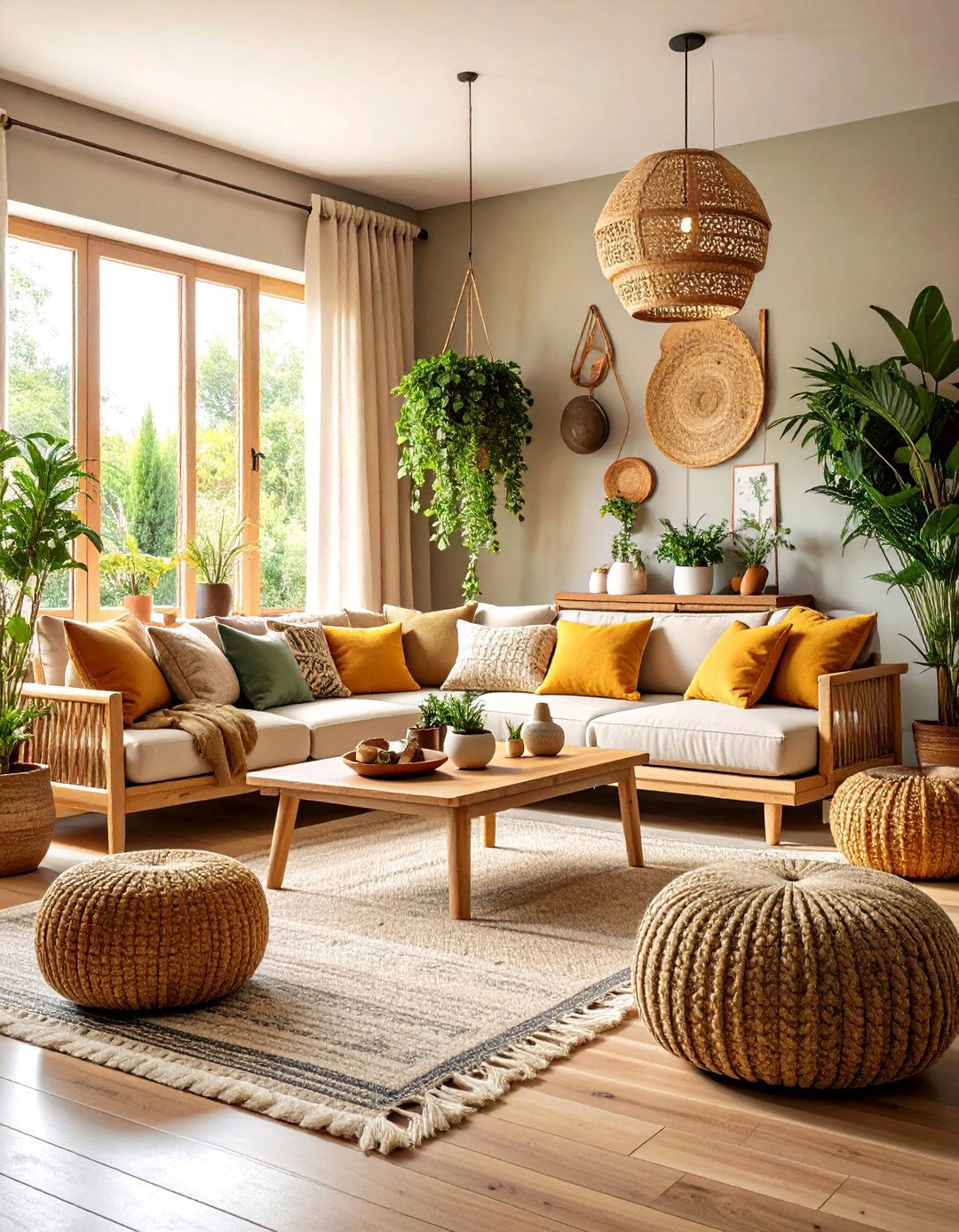
Sustainability continues as a driving force with consumers prioritizing furniture and decor that minimize carbon footprints, featuring reclaimed wood, bamboo, and recycled metals. Build an environmentally conscious family room using reclaimed wood furniture, bamboo accessories, and recycled metal fixtures. Choose furniture made from sustainably sourced materials or invest in vintage pieces that gain character over time. Select organic cotton or hemp fabrics for upholstery and window treatments. Include live plants in reclaimed planters to improve air quality naturally. Look for modular furniture pieces that can be reconfigured as your family grows and changes. These choices create a healthier environment for your family while supporting responsible manufacturing practices, proving that sustainable design doesn't require compromising on style or comfort.
12. Family Room Neutral Earth Tone Palette
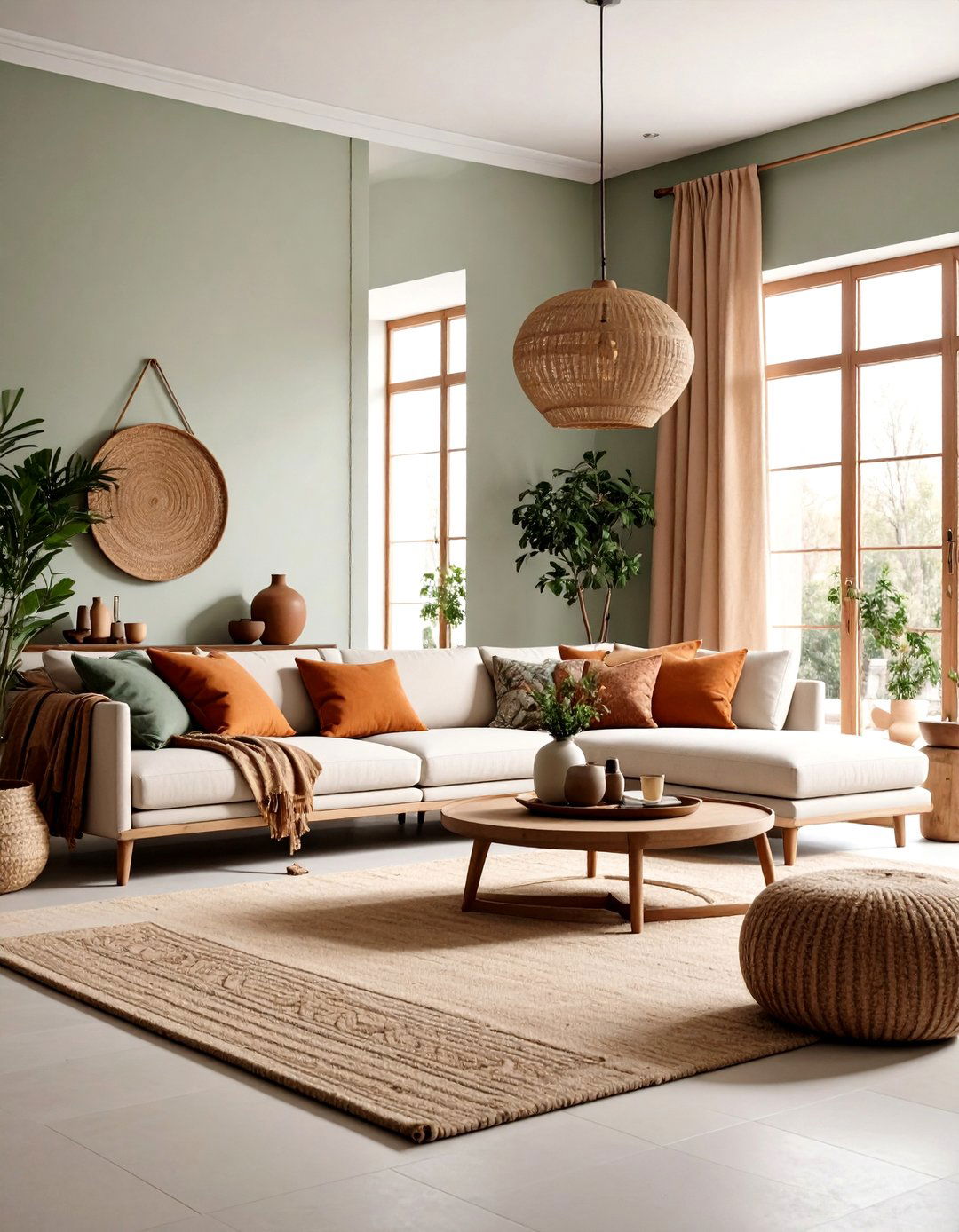
Earthy neutrals like terracotta, ochre, and sage bring a grounding, calming effect to interiors, reflecting nature and promoting tranquility. Create a serene family environment using warm, earth-inspired colors that promote relaxation and connection. Start with walls in soft sage or warm mushroom, then layer in furniture in rich terracotta, deep ochre, and cream tones. Include natural materials like jute rugs, wooden furniture, and stone accessories to reinforce the organic feel. These colors work beautifully with both modern and traditional furniture styles, creating a timeless backdrop that won't feel dated in a few years. The palette naturally complements family life, hiding minor stains and wear while creating a sophisticated atmosphere that feels both grown-up and child-friendly.
13. Family Room Maximalist Pattern Play
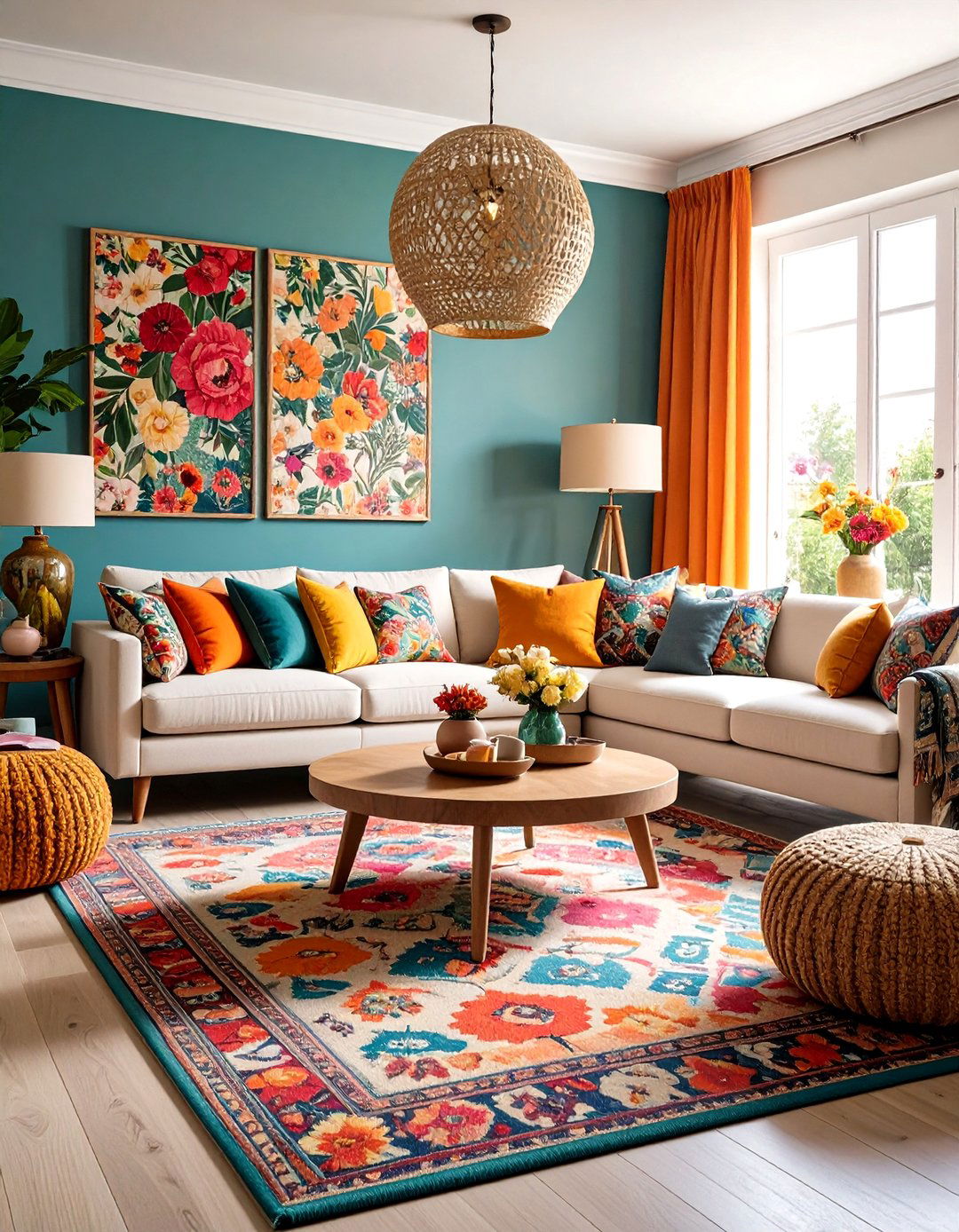
The shift from minimalism to maximalism embraces vibrant patterns and textures, with pattern play being a big part of this movement through pillows, wallpaper, or upholstery. Embrace bold patterns and textures to create a vibrant, personality-driven family room. Mix florals with geometrics and stripes, keeping them unified through a consistent color palette. Layer patterned throw pillows on solid furniture, or choose one statement piece like a boldly patterned sofa balanced with neutral walls and accessories. Include patterned rugs, curtains, or wallpaper as anchor elements. The key to successful pattern mixing is varying the scale—pair large-scale patterns with smaller ones and include some solid elements for visual rest. This approach creates an energetic, welcoming environment that reflects your family's dynamic personality while providing visual interest from every angle.
14. Family Room Multi-Functional Workspace
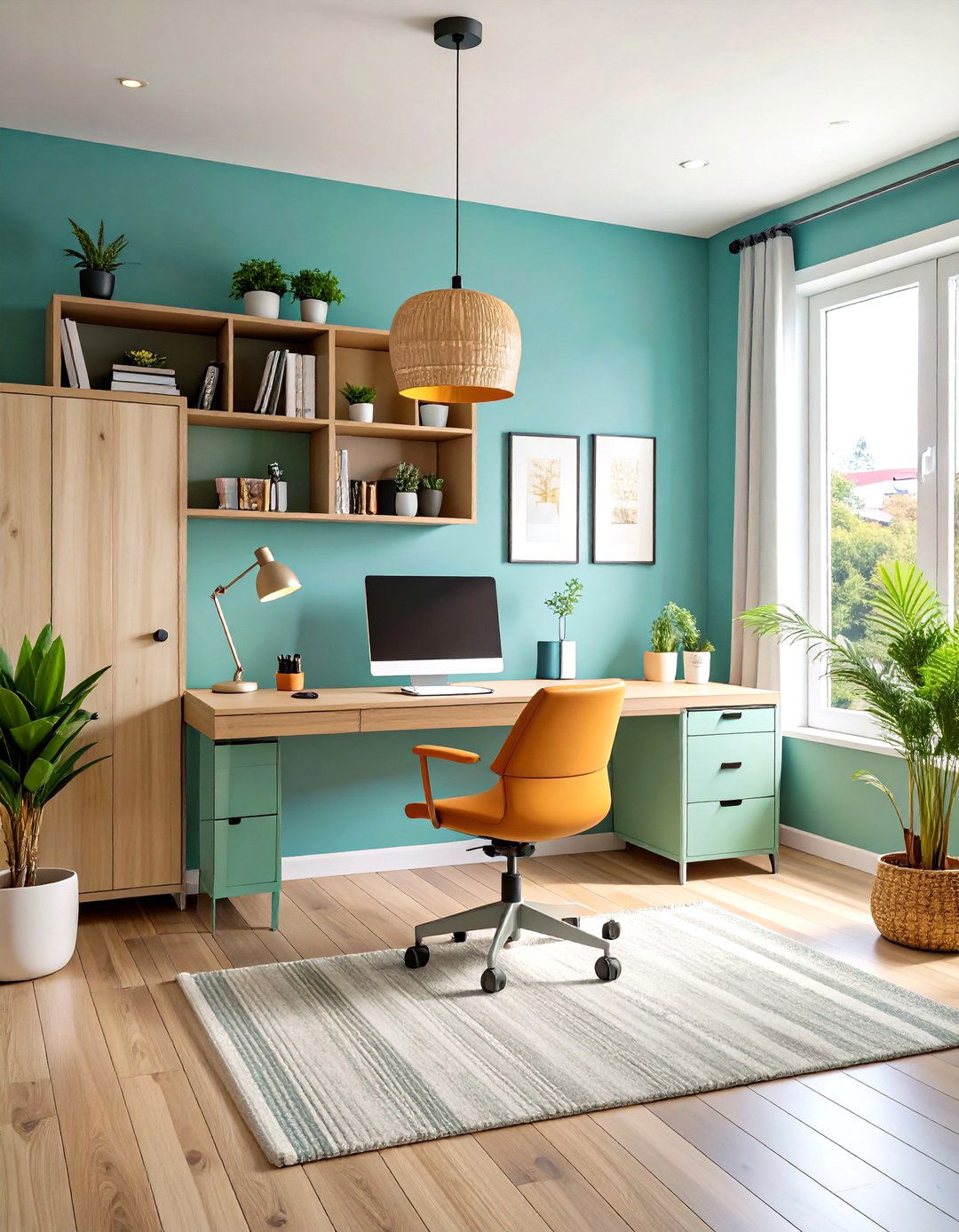
Adding pieces like bookshelves, desks, work tables, or built-in counters for homework and document organization can be lifesavers for family organization. Design a dedicated work zone within your family room to accommodate remote work and children's homework needs. Install a built-in desk along one wall with adequate electrical outlets for computers and devices. Include organized storage for supplies, files, and school materials in attractive bins or built-in drawers. Position the workspace where parents can supervise children's activities while maintaining their own productivity. Choose a desk height that works for both adults and children, or consider an adjustable-height option. Ensure good task lighting and comfortable seating. This integration allows families to work together while maintaining the room's primary function as a relaxation and entertainment space.
15. Family Room Gallery Wall Display
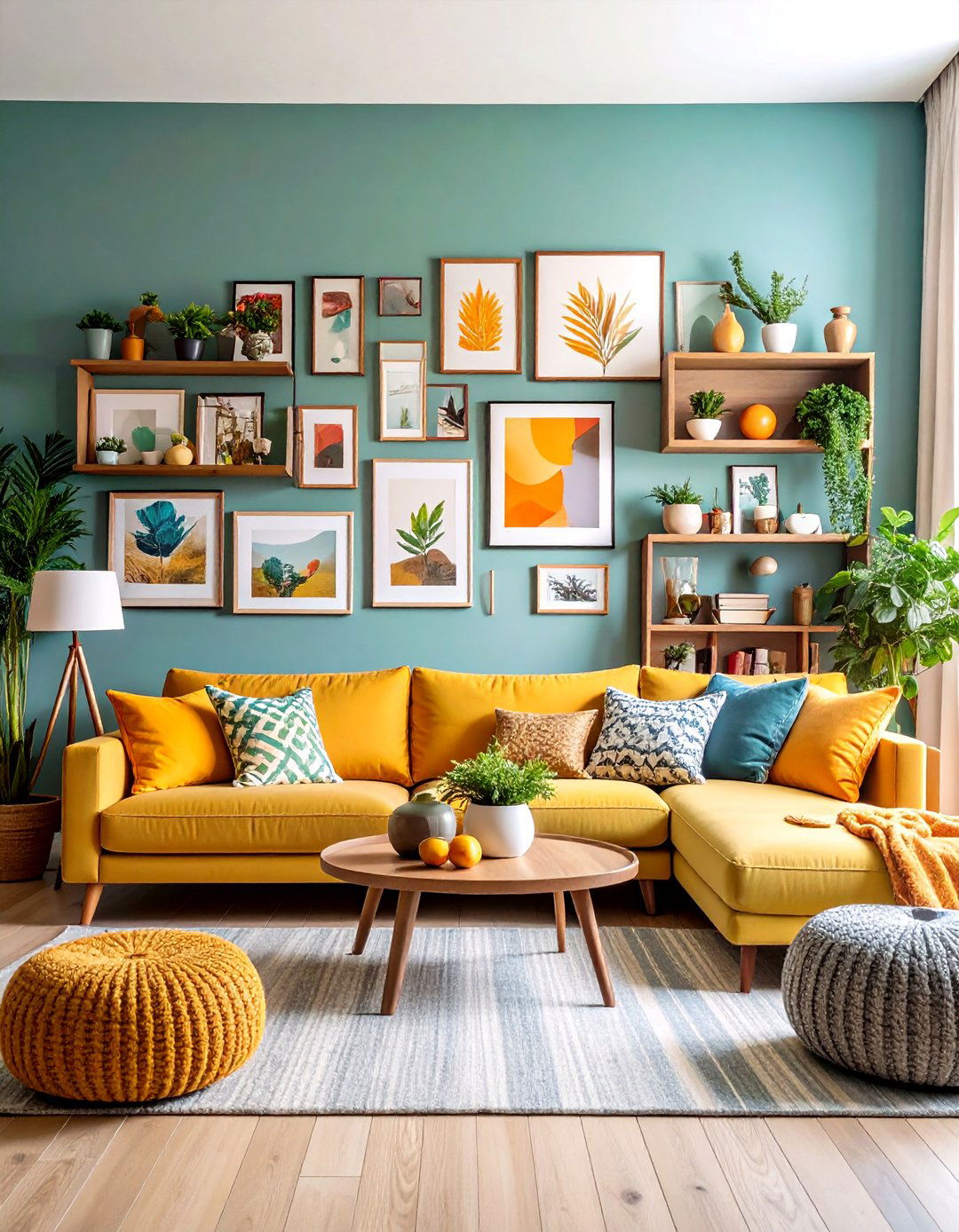
Personalized art displays showcase individuality and personal taste through collections of family photos, commissioned artwork, or DIY creations. Create a meaningful focal point with a curated gallery wall that reflects your family's interests and memories. Mix family photographs with artwork, children's creations, and meaningful objects in varying frame sizes and styles. Plan the layout on the floor first, then transfer to the wall using paper templates. Include three-dimensional elements like small shelves for treasured objects or shadow boxes for memorabilia. Update the display seasonally or as children grow, making it a living reflection of your family's journey. Position the gallery wall where it can be easily viewed and enjoyed, perhaps above a sofa or along a hallway leading to the family room.
16. Family Room Statement Ceiling Design

Choosing a ceiling color like slate blue instead of painting walls can differentiate spaces and create dramatic impact. Draw the eye upward with a dramatic ceiling treatment that adds architectural interest without overwhelming the space. Consider painted ceiling beams in a contrasting color, or install a coffered ceiling for traditional elegance. Shiplap or tongue-and-groove planking adds rustic charm, while a bold paint color creates contemporary drama. Wallpaper on the ceiling can add pattern and texture in unexpected places. Include recessed lighting or a statement chandelier to highlight the ceiling treatment. This approach adds significant visual impact while keeping wall space available for furniture and storage. A well-designed ceiling becomes the room's fifth wall, contributing to the overall aesthetic while maintaining functional floor space.
17. Family Room Natural Material Integration
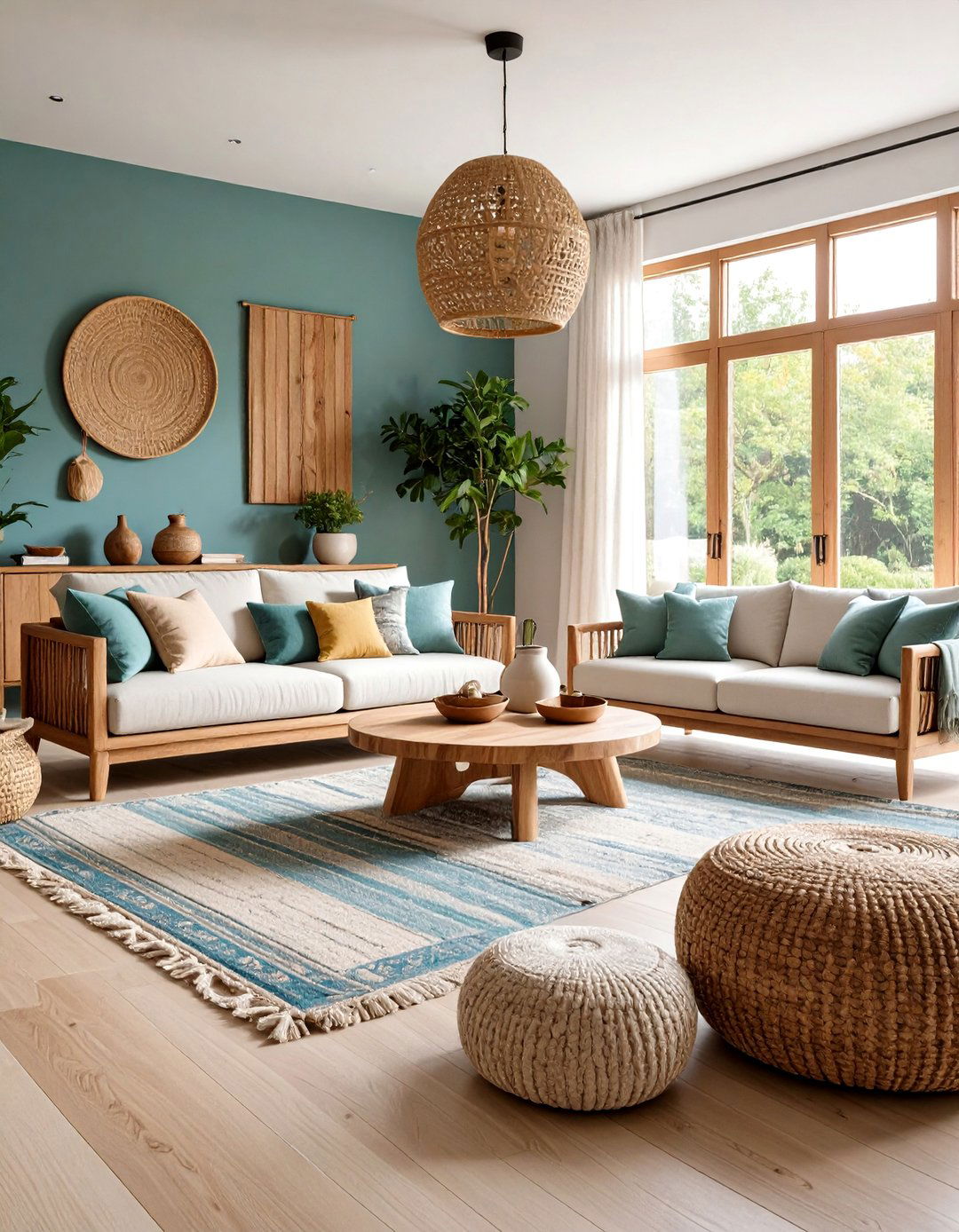
Natural textures like wood, stone, and linen bring an organic feel with earthy, tactile quality that feels both grounding and luxurious. Bring the outdoors inside through thoughtful integration of natural materials that add warmth and texture. Include live-edge wood furniture, stone accent walls, and linen upholstery to create organic appeal. Add woven baskets for storage, jute rugs for grounding, and ceramic accessories for subtle elegance. Consider a stone fireplace surround or wood beam ceiling for architectural impact. These materials age beautifully and improve with use, making them perfect for active family spaces. The natural elements create a calming environment that connects your family with nature while providing durable, practical surfaces that withstand daily use and maintain their beauty over time.
18. Family Room Conversation Area Setup
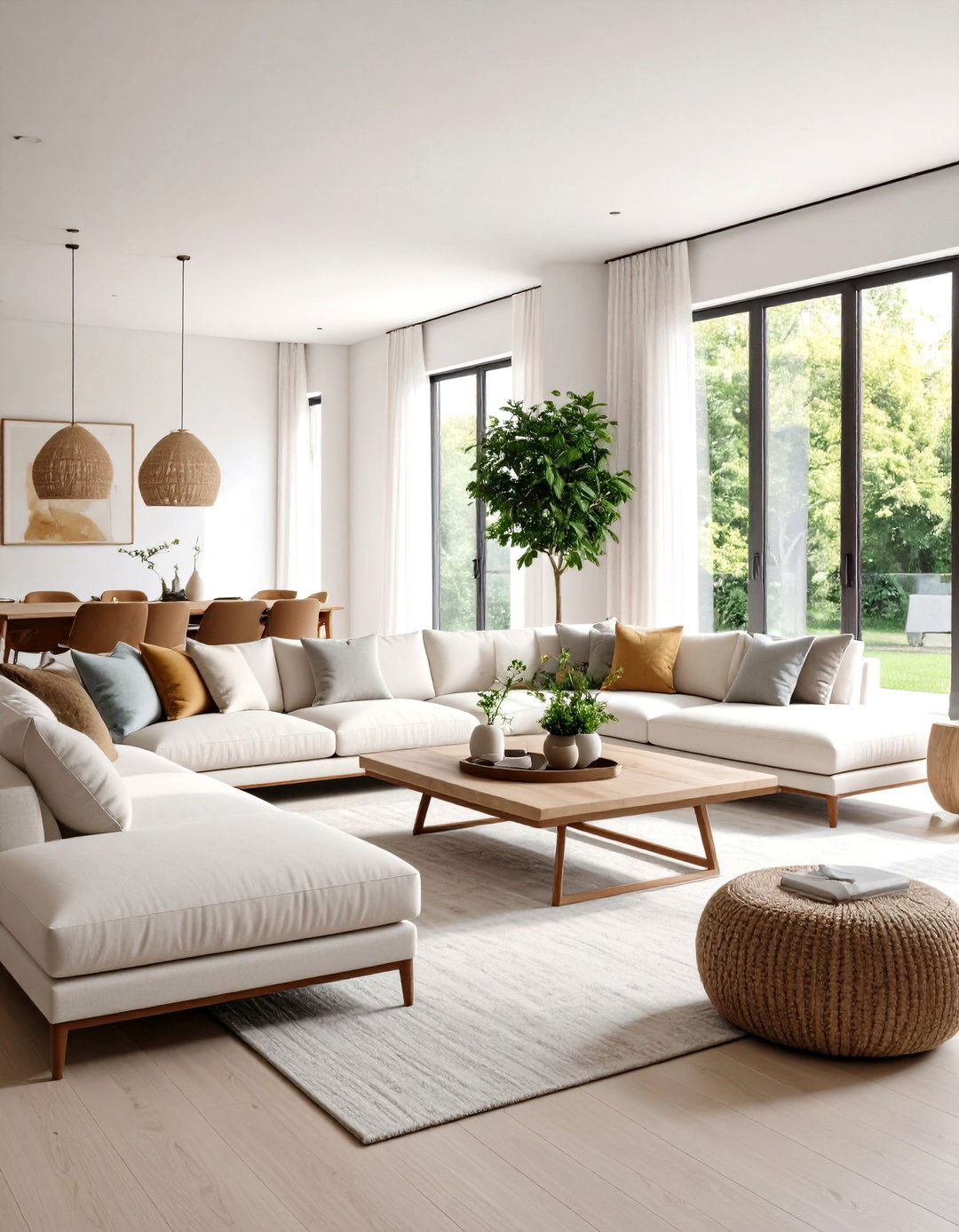
People are seeking to transform living rooms into central gathering spaces where guests can mingle over cocktails and conversation rather than focusing solely on media entertainment. Arrange furniture to encourage face-to-face interaction and meaningful conversation among family members and guests. Position seating in a U-shape or circular arrangement around a central coffee table, ensuring everyone can see and hear each other comfortably. Include various seating options—sofas, chairs, and ottomans—to accommodate different preferences and group sizes. Add side tables within reach of every seat for beverages and personal items. Keep the television secondary to the seating arrangement, perhaps mounted to the side rather than as the central focal point. This layout prioritizes human connection while maintaining the room's entertainment capabilities.
19. Family Room Performance Fabric Selection
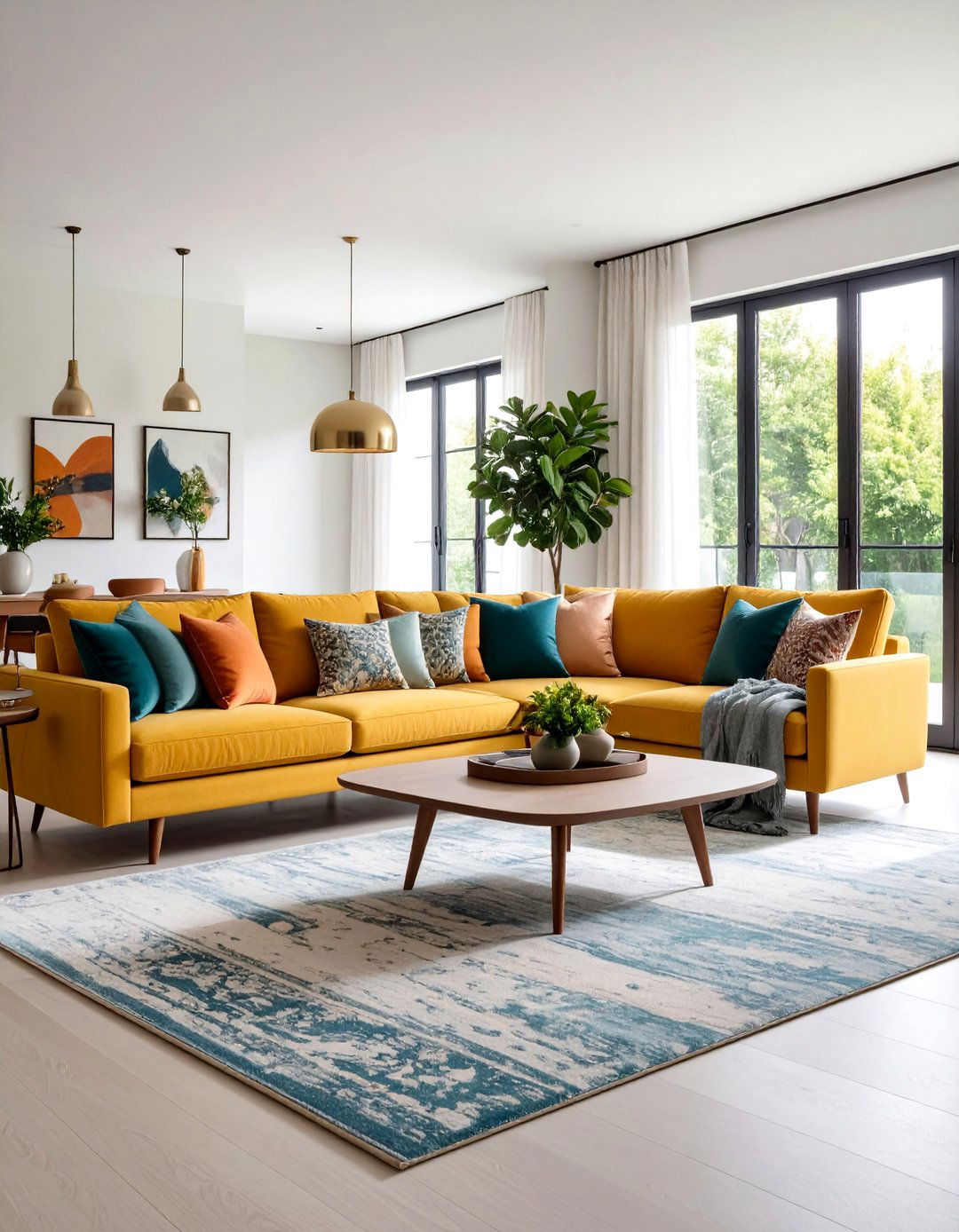
Performance fabrics on furniture help transform spaces into welcoming areas while being functional and kid or pet-friendly with easy-to-clean materials. Invest in high-performance fabrics that maintain beauty while withstanding family life's demands. Choose sofas and chairs upholstered in stain-resistant, durable fabrics that clean easily without sacrificing style. Modern performance fabrics come in sophisticated colors and textures that rival traditional options. Include washable slipcovers for easy maintenance and seasonal updates. Select area rugs with stain-resistant treatments and low-pile construction for easy cleaning. These practical choices allow your family to fully enjoy the space without constant worry about spills or damage. Performance fabrics prove that functional can be beautiful, enabling relaxed family living in an elegant environment.
20. Family Room Seasonal Refresh Strategy
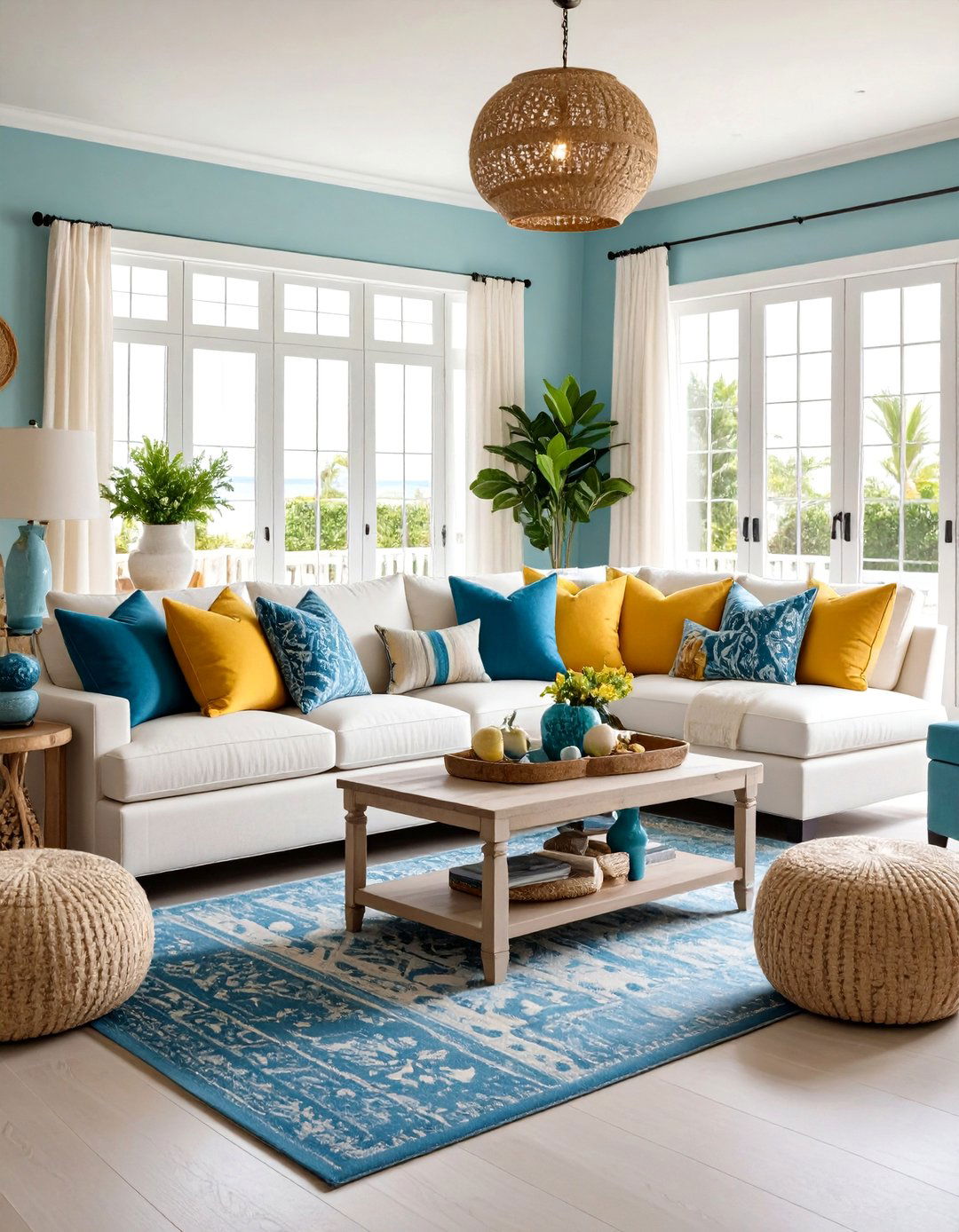
Switching to coastal style accessories and decor creates different seasonal atmospheres through simple changes in textiles, colors, and decorative objects. Develop a systematic approach to refreshing your family room throughout the year without major renovations. Establish a neutral foundation with larger furniture pieces, then change throw pillows, blankets, and accessories seasonally. Create storage for off-season items like winter throws or summer coastal decor. Plan color transitions—perhaps warm oranges and deep reds for fall, cool blues and whites for summer. Change artwork temporarily with removable wallpaper or interchangeable frames. Include seasonal plants and flowers to bring natural elements indoors. This strategy keeps your family room feeling fresh and current while working within budget constraints, allowing you to experiment with trends without permanent commitment.
Conclusion:
These twenty family room ideas demonstrate how current design trends can enhance your family's daily life while creating a space that's both stylish and functional. The 2025 trends emphasize sensorial experiences that speak to all senses, creating wholesome environments. Whether you choose comfort-driven sectionals, jewel tone accents, or sustainable materials, the key is balancing your family's practical needs with design elements that reflect your personal style. Remember that the best family rooms evolve with your family, providing a foundation for countless memories while adapting to changing needs and preferences over time.


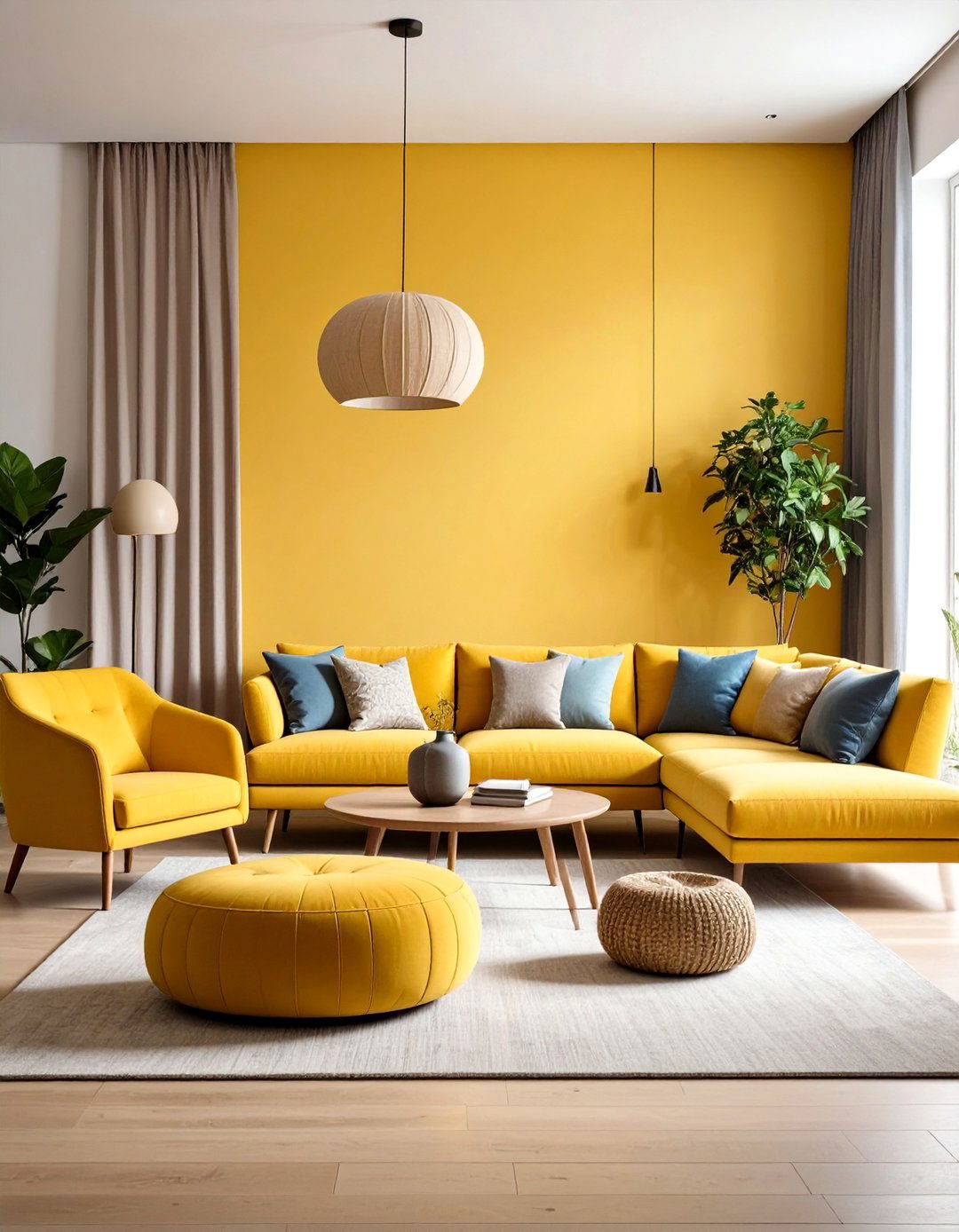
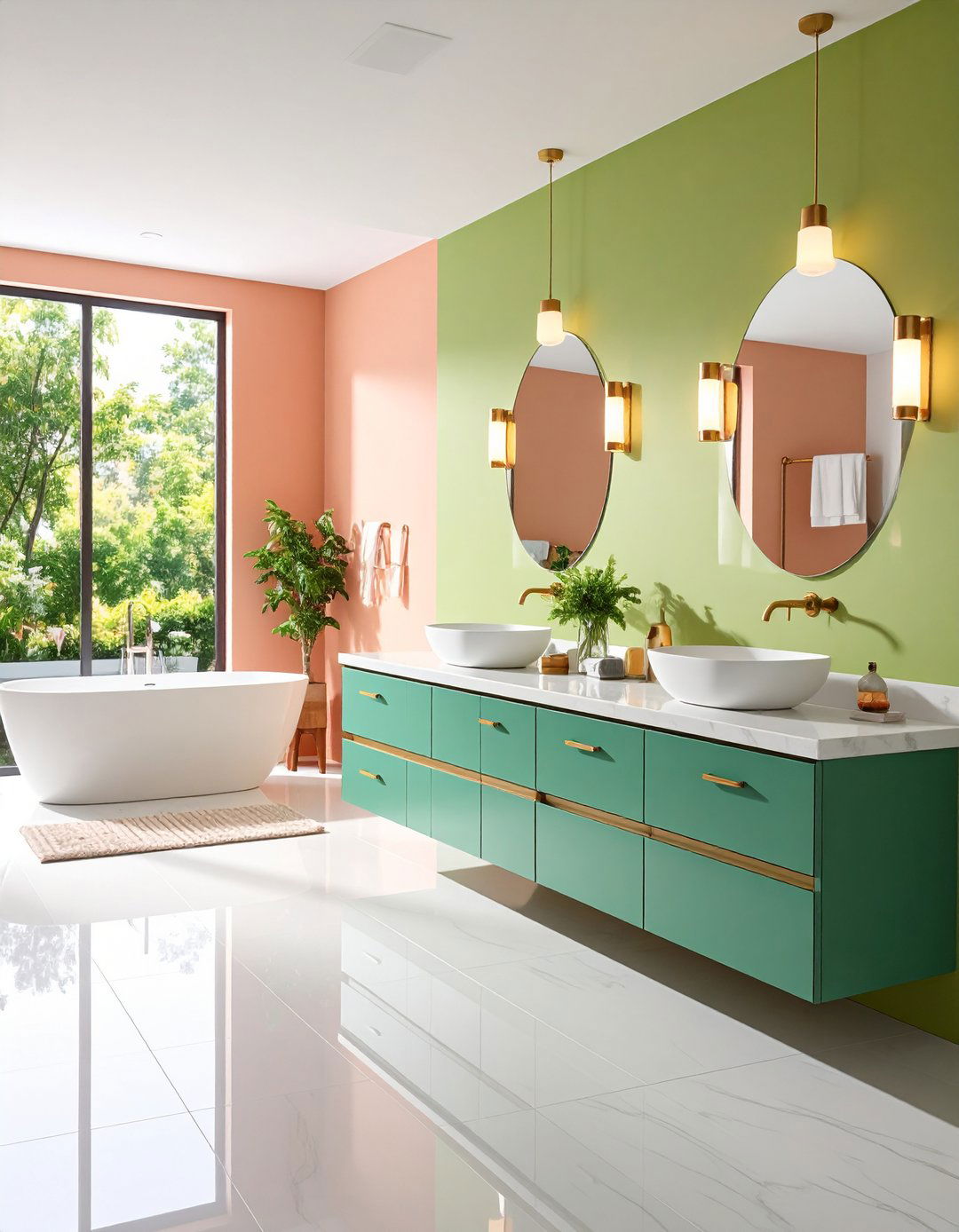

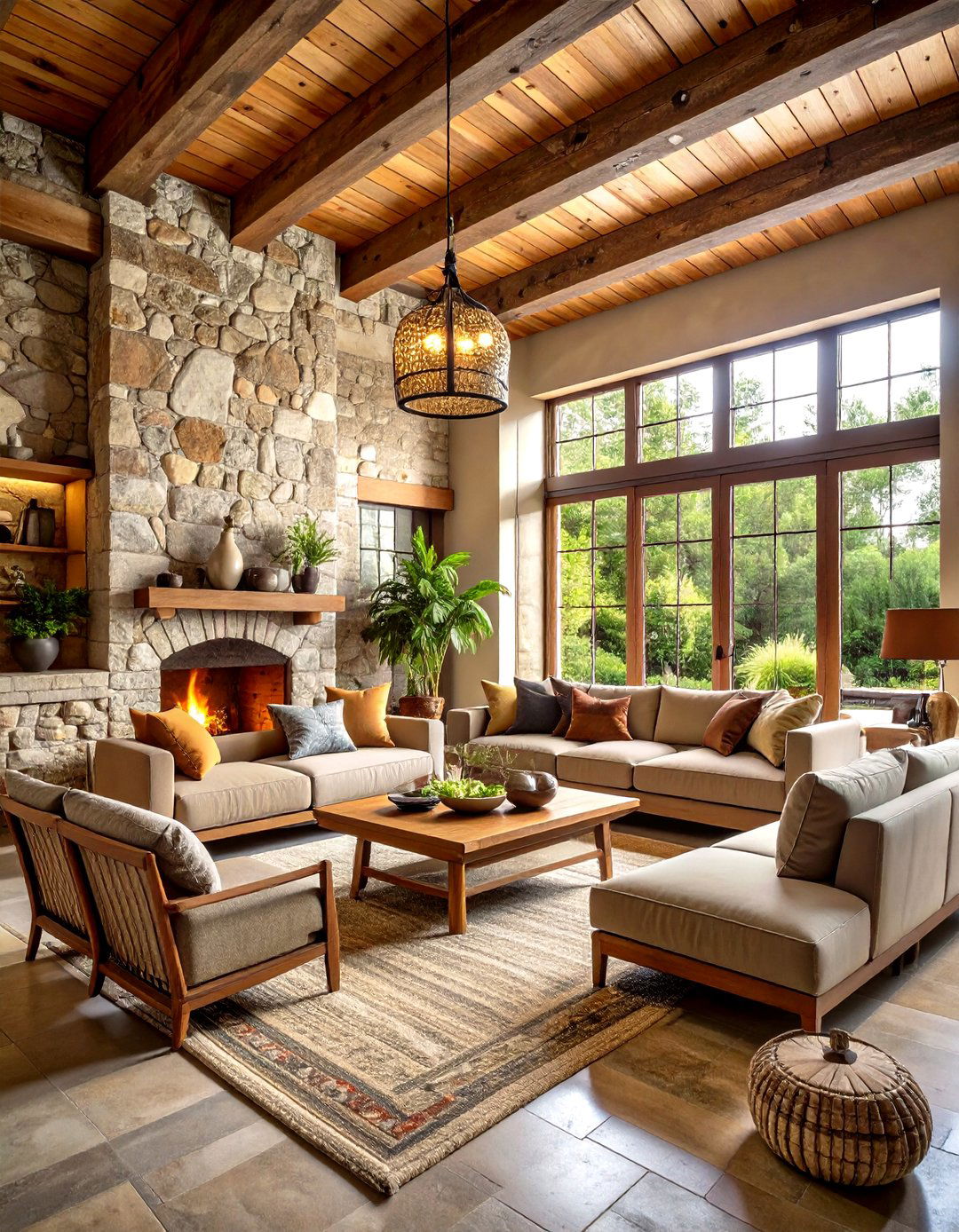
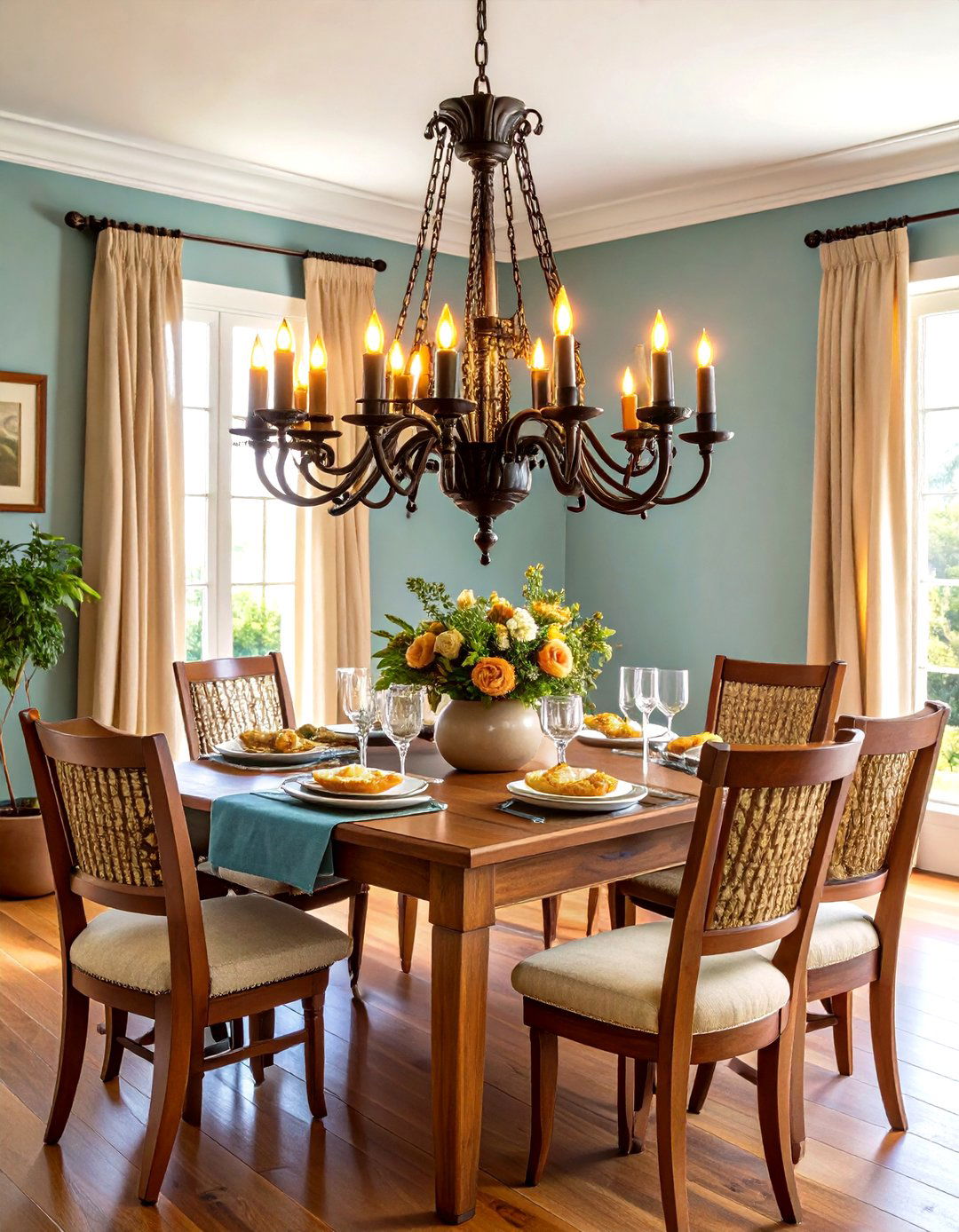

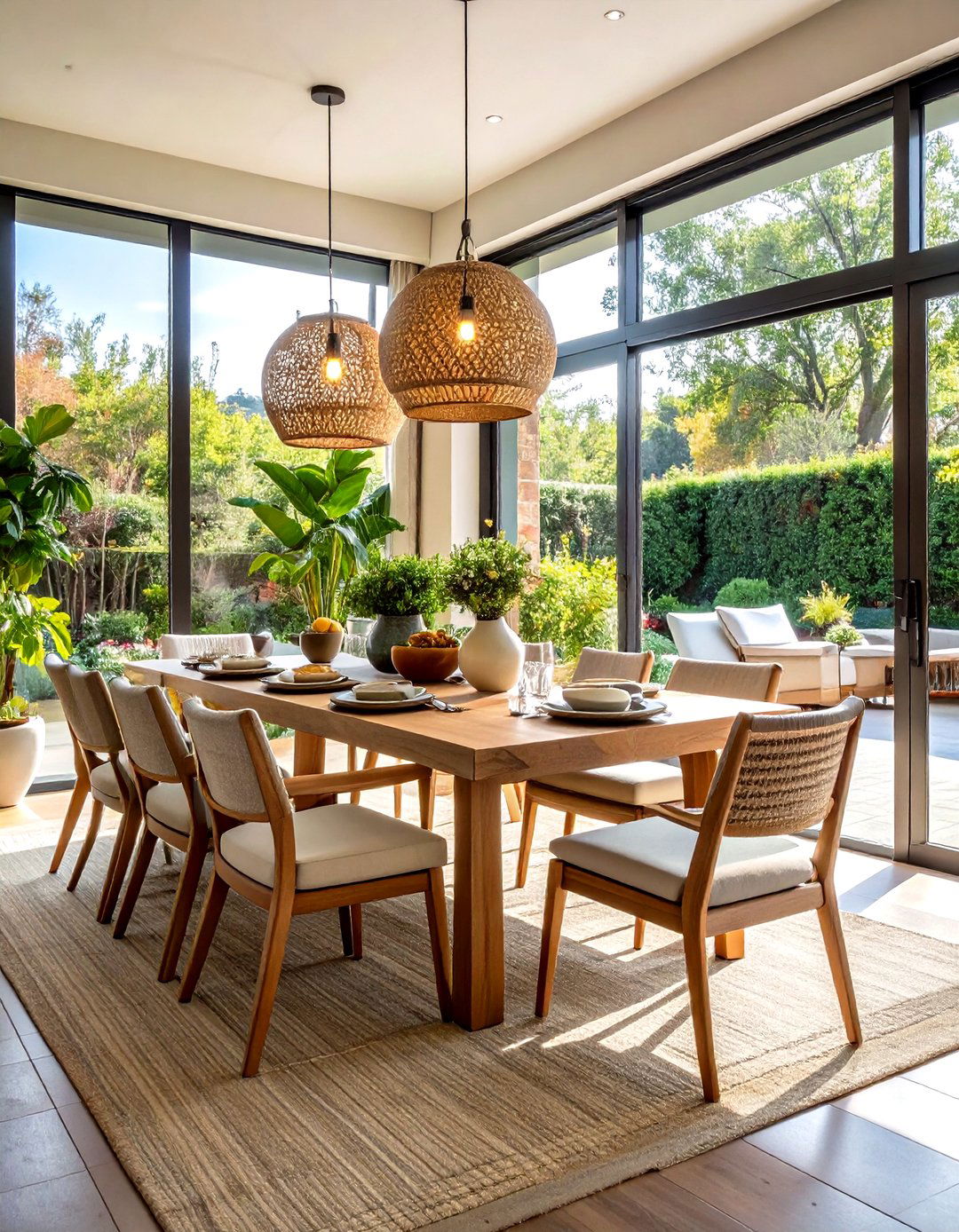
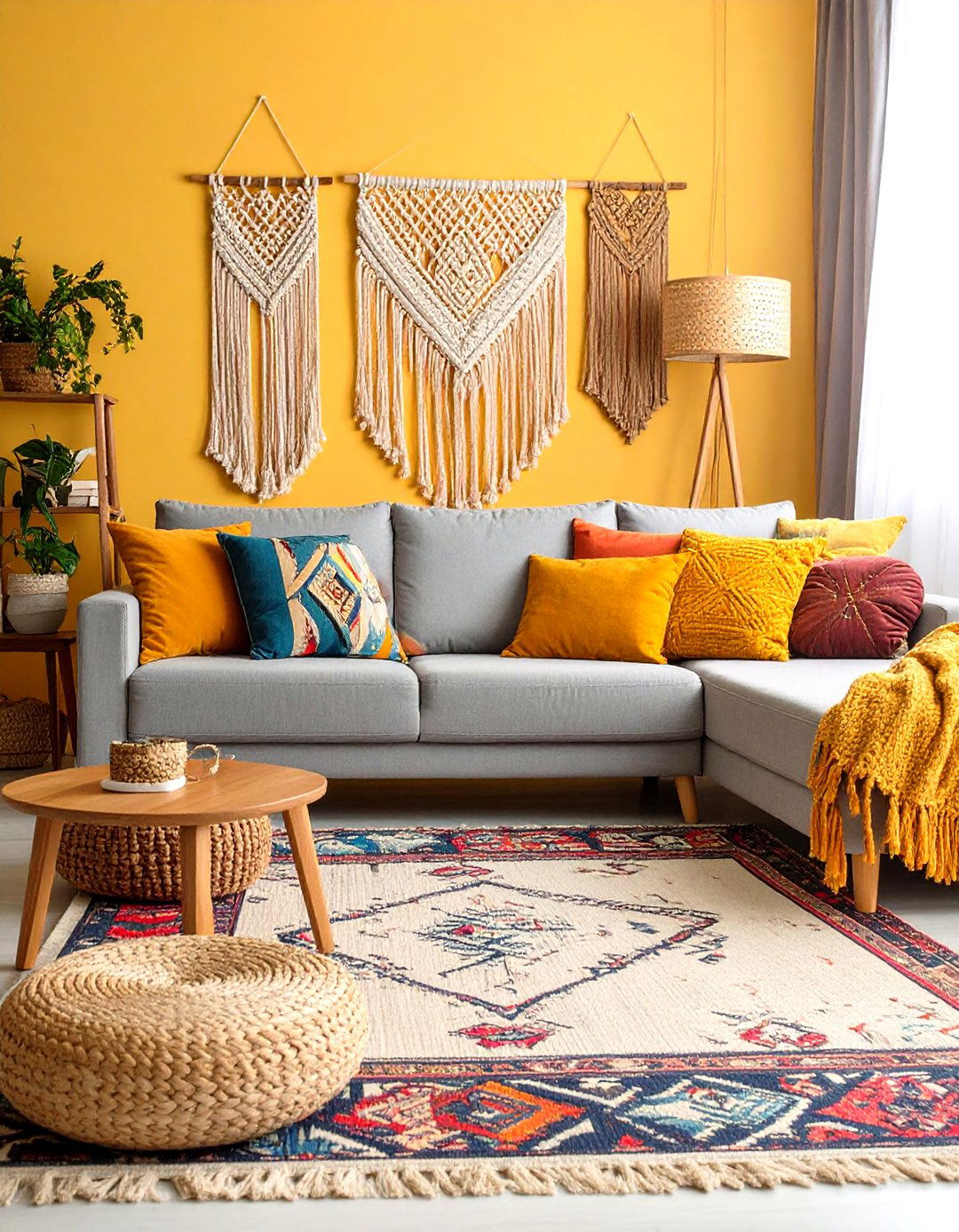

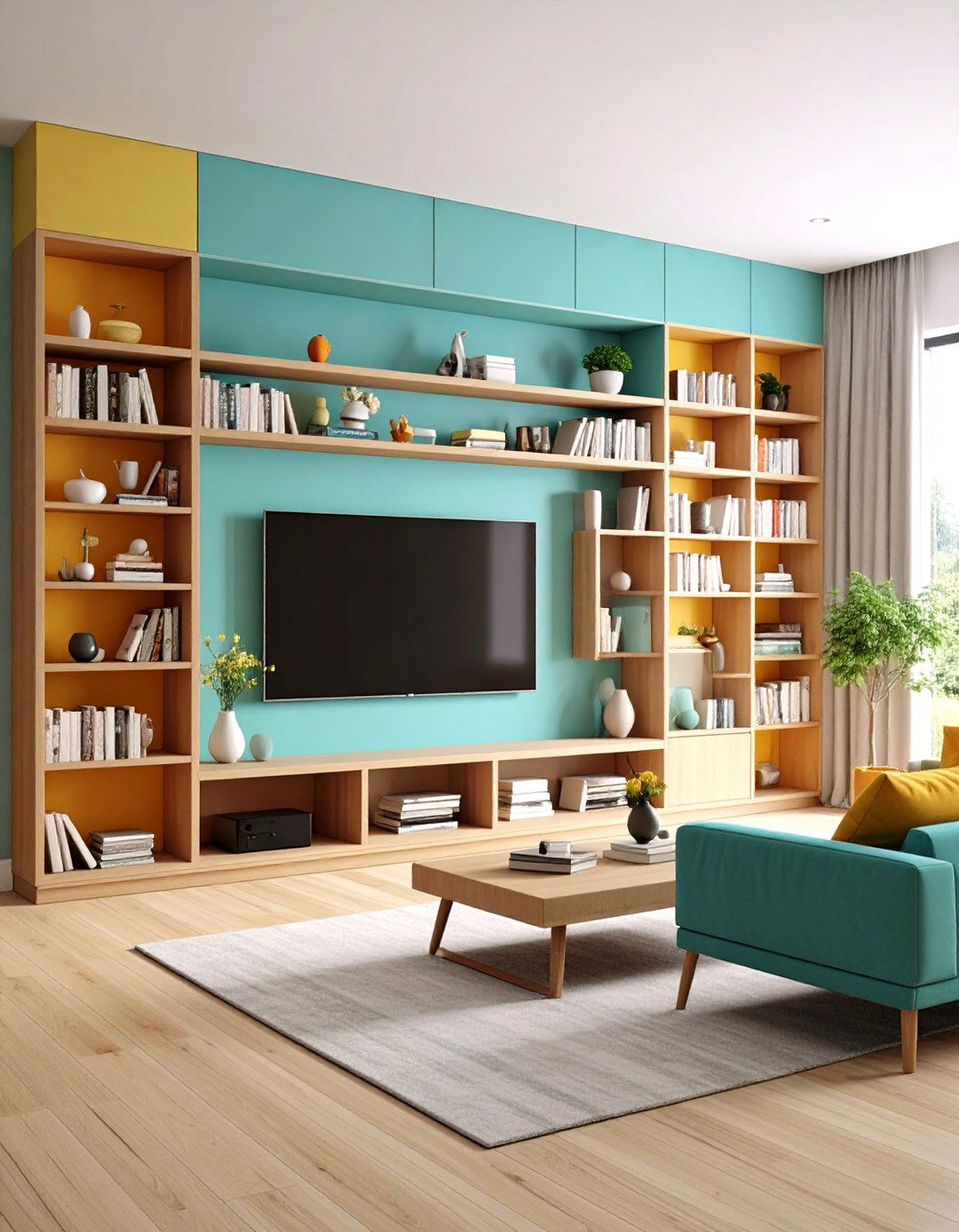
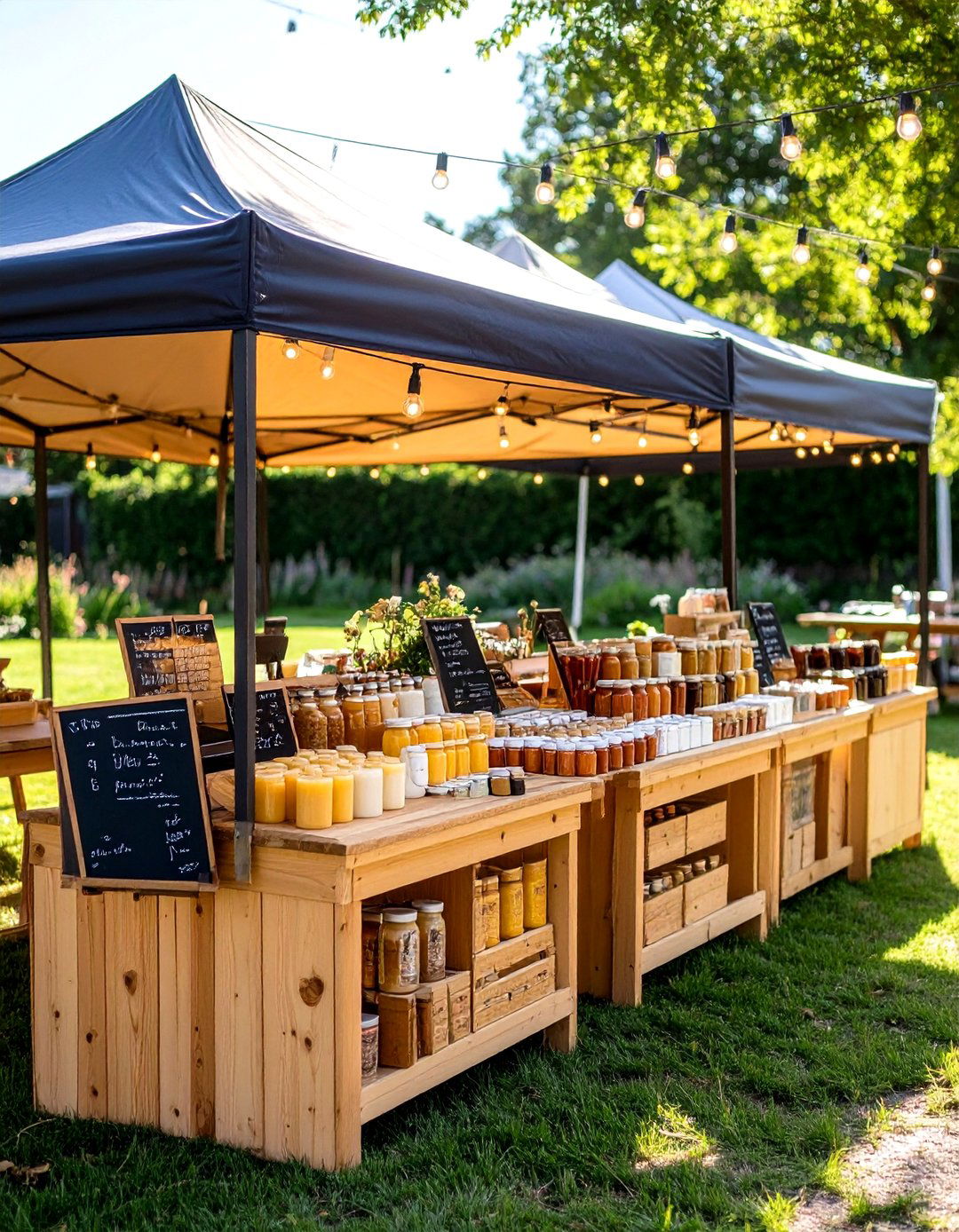
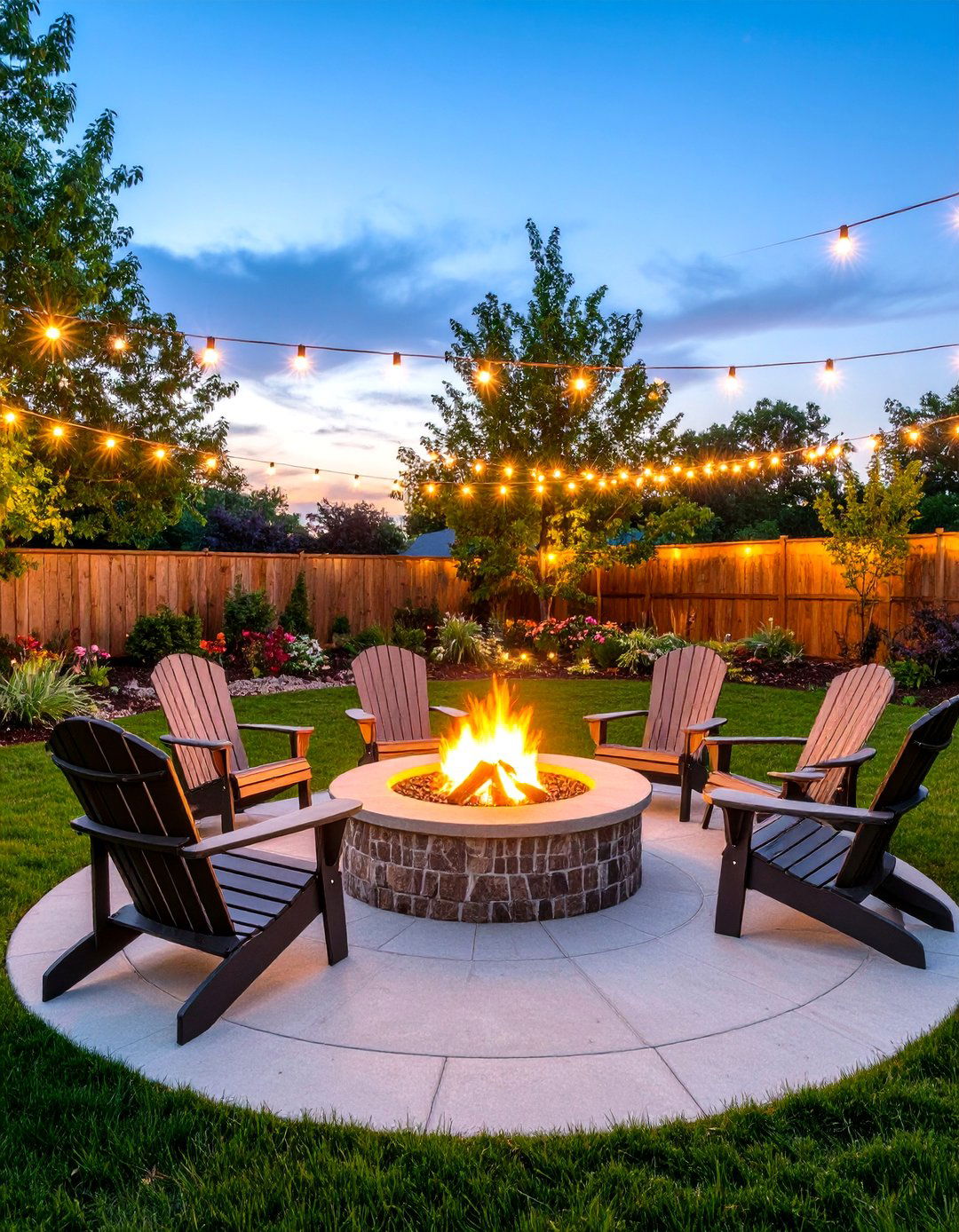

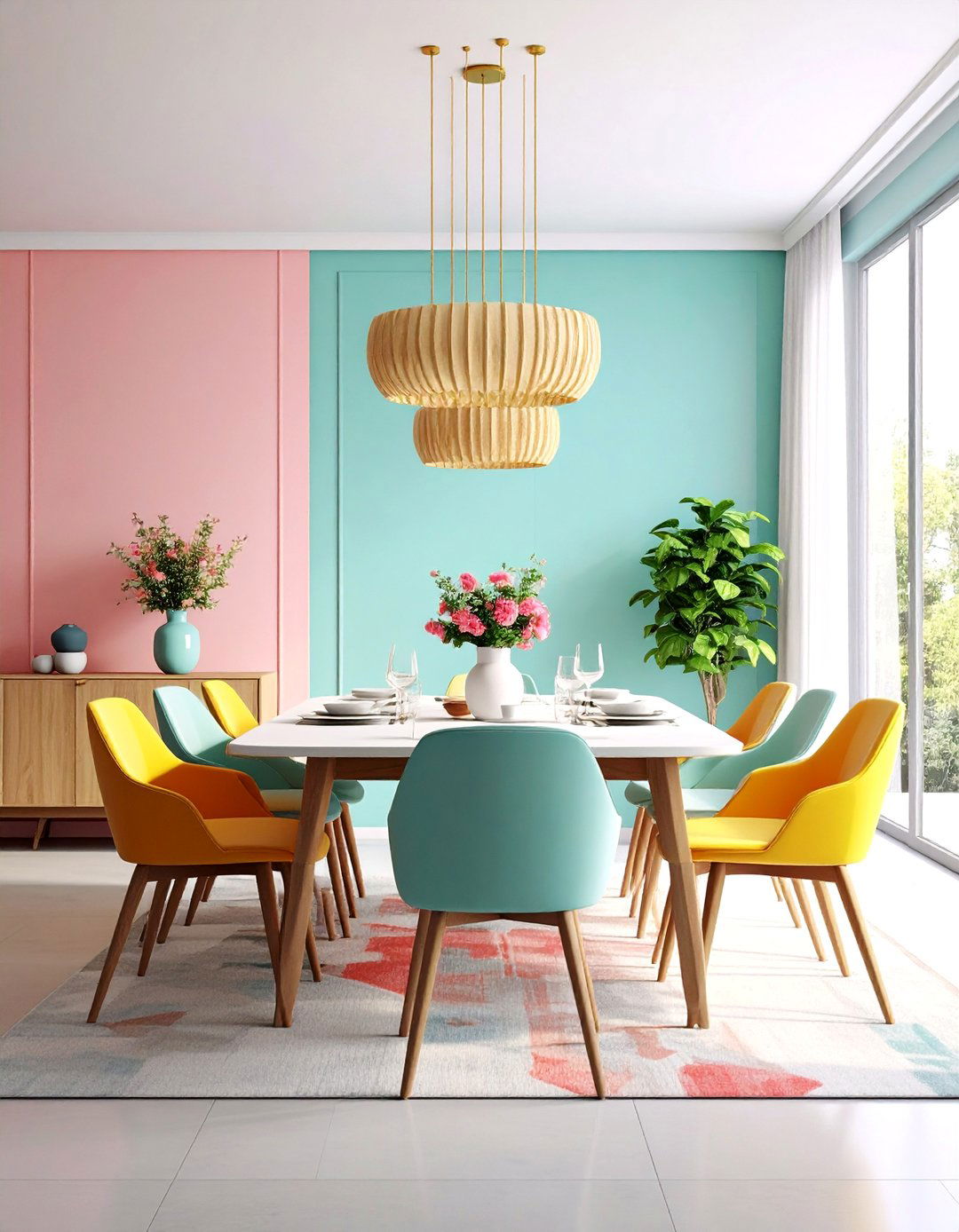
Leave a Reply